AP Art History 250 Study Guide (2022-2023)
5.0(1)
5.0(1)
Card Sorting
1/118
Earn XP
Study Analytics
Name | Mastery | Learn | Test | Matching | Spaced |
|---|
No study sessions yet.
119 Terms
1
New cards

Apollo 11 Stones
25000-25300 B.C.E.
Mesolithic (Sub-Saharan) Africa
Charcoal on stone
Nambia, Southern Africa
Content: Oldest figurative art known in Africa, composite figure of animal
Context: Found using archeological stratigraphy
Function: Possibly animistic or shamanistic or mobilary used for better hunts, communicating with spirit world, establish power of shaman etc
25000-25300 B.C.E.
Mesolithic (Sub-Saharan) Africa
Charcoal on stone
Nambia, Southern Africa
Content: Oldest figurative art known in Africa, composite figure of animal
Context: Found using archeological stratigraphy
Function: Possibly animistic or shamanistic or mobilary used for better hunts, communicating with spirit world, establish power of shaman etc
2
New cards

Great Hall of the Bulls
15000-13000 BCE
Paleolithic Europe
Rock painting, pigment blown through bones
Lascaux, France
Content: naturalistic animals (variety of species) and space, and abstract symbols
Context: found in remote area of cave (hard to reach and dark), continuously added on through years
Function: “hunting magic” animal hunting rituals, likely considered sacred
15000-13000 BCE
Paleolithic Europe
Rock painting, pigment blown through bones
Lascaux, France
Content: naturalistic animals (variety of species) and space, and abstract symbols
Context: found in remote area of cave (hard to reach and dark), continuously added on through years
Function: “hunting magic” animal hunting rituals, likely considered sacred
3
New cards

Camelid sacrum in the shape of a canine
14000-7000 BCE
Fossilized remains of sacrum from extinct camelid
Tequixquiac, Mexico (Valley of Mexico)
Content: made of bone from base of spine with holes cut in to resemble a dog-like creature
Context: was made before camelid went extinct, much unknown
Function: for Mesoamerica sacrum = sacred
14000-7000 BCE
Fossilized remains of sacrum from extinct camelid
Tequixquiac, Mexico (Valley of Mexico)
Content: made of bone from base of spine with holes cut in to resemble a dog-like creature
Context: was made before camelid went extinct, much unknown
Function: for Mesoamerica sacrum = sacred
4
New cards

Running Horned Woman
6000-4000 BCE
Neolithic Africa
Ochre pigment on rock
Tassili n’ Ajjer, Algeria (northwestern Africa)
Content: possibly hierarchical scale, horns imply goddess/anthropromorphic, elaborate ritual costume, area above head may be rain cloud, lack in face implies the figure may represent something
Context: Other pieces from same location are ritualistic
Function: Maybe spiritual/ritualistic or depicting ritual/dance
6000-4000 BCE
Neolithic Africa
Ochre pigment on rock
Tassili n’ Ajjer, Algeria (northwestern Africa)
Content: possibly hierarchical scale, horns imply goddess/anthropromorphic, elaborate ritual costume, area above head may be rain cloud, lack in face implies the figure may represent something
Context: Other pieces from same location are ritualistic
Function: Maybe spiritual/ritualistic or depicting ritual/dance
5
New cards

Beaker with Ibex Motifs
4200-3500 BCE
Susa I period
Painted terracotta
Susa, Iran
Content: Uses registers, stylization, emphasized goat horns, decorative sense shows artist is aware of space and composition
Context: Found in burial site, made during neolothic revolution when people became less nomadic, uses tools
Function: Burial ritual, storage implies people had excess
4200-3500 BCE
Susa I period
Painted terracotta
Susa, Iran
Content: Uses registers, stylization, emphasized goat horns, decorative sense shows artist is aware of space and composition
Context: Found in burial site, made during neolothic revolution when people became less nomadic, uses tools
Function: Burial ritual, storage implies people had excess
6
New cards

White Temple and its Ziggurat
3500-3000 BCE
Sumerian
Mudbrick
Uruk (modern Warka, Iraq)
Content: meant to be enjoyed from the outside, depressions on side meant to emphasize height and give perspective
Context: Ziggurat = higher and closer to god, taller place to appeal to gods, culture under theocracy (under rule of gods) and ruler was representation of god
Function: Worship
3500-3000 BCE
Sumerian
Mudbrick
Uruk (modern Warka, Iraq)
Content: meant to be enjoyed from the outside, depressions on side meant to emphasize height and give perspective
Context: Ziggurat = higher and closer to god, taller place to appeal to gods, culture under theocracy (under rule of gods) and ruler was representation of god
Function: Worship
7
New cards

Anthropomorphic Stele
3999-3000 BCE
Nabatean people
Sandstone
Arabian Peninsula
Content: Stele = standing stone slab, very stylized, barely human
Context: Found on trade route
Function: Possible landmark or guardian figure to ward off evil
3999-3000 BCE
Nabatean people
Sandstone
Arabian Peninsula
Content: Stele = standing stone slab, very stylized, barely human
Context: Found on trade route
Function: Possible landmark or guardian figure to ward off evil
8
New cards

Jade Cong
3300-2200 BCE
Liangzhu people
Carved jade
Liangshu, China
Content: Jade is very hard and carved by abrasives (takes much effort/time), corners have rudementary faces, circle + square motifs (possibly sky/earth meaning)
Context: culture had abundance of food, making them able to support artisan class
Function: Unknown, but found in graves
3300-2200 BCE
Liangzhu people
Carved jade
Liangshu, China
Content: Jade is very hard and carved by abrasives (takes much effort/time), corners have rudementary faces, circle + square motifs (possibly sky/earth meaning)
Context: culture had abundance of food, making them able to support artisan class
Function: Unknown, but found in graves
9
New cards

Palette of King Narmer
3000-2920 BCE
Predynastic Egypt
Greywacke
Heirakonpolis, Egypt
Content: contains narrative of unifying upper+lower Egypt, contains registers, gods as animals, heirarchal scale, composite figures, mix of angles, bent and broken enemies,
Context: Egypt could support artisan class because of abundance of food because of Nile River, hierarchal society
Function: to mix makeup on, protrays King Narmer as powerful
3000-2920 BCE
Predynastic Egypt
Greywacke
Heirakonpolis, Egypt
Content: contains narrative of unifying upper+lower Egypt, contains registers, gods as animals, heirarchal scale, composite figures, mix of angles, bent and broken enemies,
Context: Egypt could support artisan class because of abundance of food because of Nile River, hierarchal society
Function: to mix makeup on, protrays King Narmer as powerful
10
New cards

Statues of Votive Figures from Square Temple of Eshnanna
2700 BCE
Sumerian
Gypsum inlaid with shell and black limestone
Eshnunna (modern Iraq)
Content: Votive = related to prayer, each statue is of an actual person (individualized), blocky figures, everyone wears skirts
Context: Comissioned by wealthy to maintain prayer, statue of women means women could have power/authority
Function: to keep the people depicted always praying
2700 BCE
Sumerian
Gypsum inlaid with shell and black limestone
Eshnunna (modern Iraq)
Content: Votive = related to prayer, each statue is of an actual person (individualized), blocky figures, everyone wears skirts
Context: Comissioned by wealthy to maintain prayer, statue of women means women could have power/authority
Function: to keep the people depicted always praying
11
New cards

Seated Scribe
2600 BCE
Old Kingdom, 4th Dynasty
Painted Limestone
Saqqara, Egypt
Content: Not idealized, could be an actual person, naturalistic, sitting attentively
Context: Found in tomb of pharaoh, scribe = important job
Function: For pharaoh to take with to the afterlife, shows importance of education in Egypt
2600 BCE
Old Kingdom, 4th Dynasty
Painted Limestone
Saqqara, Egypt
Content: Not idealized, could be an actual person, naturalistic, sitting attentively
Context: Found in tomb of pharaoh, scribe = important job
Function: For pharaoh to take with to the afterlife, shows importance of education in Egypt
12
New cards

Standard of Ur from the Royal Tombs at Ur
2600-2400 BCE
Sumerian
Wood inlaid w/ shells, lapis lazuli and red limestone
Ur (modern Tell el-Muquayyer, Iraq)
Context: Lapis was from Afghanistan which shows there was trade, found in royal tombs/burial site = mass graves (buried attendants with them), standard = work meant to be supported by a pole
Content: Registers, composite view, War side = nude enemies for humiliation, bent and broken axis, soldiers in uniform to show discipline. Peace side = Queen Puabi, shows hierarchy bc top is nobles, bottom is preparation
Function: Displayed on pole, possibly a soundbox
2600-2400 BCE
Sumerian
Wood inlaid w/ shells, lapis lazuli and red limestone
Ur (modern Tell el-Muquayyer, Iraq)
Context: Lapis was from Afghanistan which shows there was trade, found in royal tombs/burial site = mass graves (buried attendants with them), standard = work meant to be supported by a pole
Content: Registers, composite view, War side = nude enemies for humiliation, bent and broken axis, soldiers in uniform to show discipline. Peace side = Queen Puabi, shows hierarchy bc top is nobles, bottom is preparation
Function: Displayed on pole, possibly a soundbox
13
New cards

Great Pyramids and Great Sphinx
2550 BCE
Old Kingdom, 4th Dynasty
Cut limestone
Giza, Egypt
Context: Blocks transported by Nile river, triangle is sacred shape, being buried below triangle means full life cycle, built by Egyptians NOT slaves, has same location as Orion Belt constellation
Content: Built on mastaba (burial), obelisk (triangle tip) represents benben (creation of world/first shape ever)
Function: Pyramids = grave markers for pharaohs and associated with temple/rituals, sphinx = guardian figure, both meant to protect from grave robbery
2550 BCE
Old Kingdom, 4th Dynasty
Cut limestone
Giza, Egypt
Context: Blocks transported by Nile river, triangle is sacred shape, being buried below triangle means full life cycle, built by Egyptians NOT slaves, has same location as Orion Belt constellation
Content: Built on mastaba (burial), obelisk (triangle tip) represents benben (creation of world/first shape ever)
Function: Pyramids = grave markers for pharaohs and associated with temple/rituals, sphinx = guardian figure, both meant to protect from grave robbery
14
New cards

King Menkaura and Queen
2490 BCE
Old Kingdom, 4th Dynasty
Greywacke
Giza, Egypt
Context: Greywacke is extremely hard stone, royalty are associated with fertility
Content: Clothes (beard/hat) are symbolism for strength, not very covering clothes and pose holding eachother are symbolism for sexuality, idealized faces and bodies
Function: to symbolize the royals permanence and strength
2490 BCE
Old Kingdom, 4th Dynasty
Greywacke
Giza, Egypt
Context: Greywacke is extremely hard stone, royalty are associated with fertility
Content: Clothes (beard/hat) are symbolism for strength, not very covering clothes and pose holding eachother are symbolism for sexuality, idealized faces and bodies
Function: to symbolize the royals permanence and strength
15
New cards

The Code of Hammurabi
1792-1750 BCE
Babylonian, Susian
Basalt
Babylon, modern Iran
Context: Reduplication = the more of something, the better (for dietys crown of many horns)
Content: Hammurabi is taller than diety, Hammurabi is getting his approval, cuneiform (wedged writing), “an eye for an eye” esque rules, diety has flame shoulders and crown of horns
Function: Symbol of authority, gives permanence to laws because they are written and displayed
1792-1750 BCE
Babylonian, Susian
Basalt
Babylon, modern Iran
Context: Reduplication = the more of something, the better (for dietys crown of many horns)
Content: Hammurabi is taller than diety, Hammurabi is getting his approval, cuneiform (wedged writing), “an eye for an eye” esque rules, diety has flame shoulders and crown of horns
Function: Symbol of authority, gives permanence to laws because they are written and displayed
16
New cards

Stonehenge
2500-1600 BCE (made in 3 phases)
Neolithic Europe
Sandstone
Wiltshire, United Kingdom
Context: Stones were brought from miles away, each part is a different kind of stone, found in the middle of nowhere,
Content: mortice and tenon joint to keep it in place
Function: Not really known, hints include- heel stone lines up with equinox, burials are around stones but not inside, possibly a dolmen where body is put on top and birds eat flesh and bones are gathered afterwards
2500-1600 BCE (made in 3 phases)
Neolithic Europe
Sandstone
Wiltshire, United Kingdom
Context: Stones were brought from miles away, each part is a different kind of stone, found in the middle of nowhere,
Content: mortice and tenon joint to keep it in place
Function: Not really known, hints include- heel stone lines up with equinox, burials are around stones but not inside, possibly a dolmen where body is put on top and birds eat flesh and bones are gathered afterwards
17
New cards
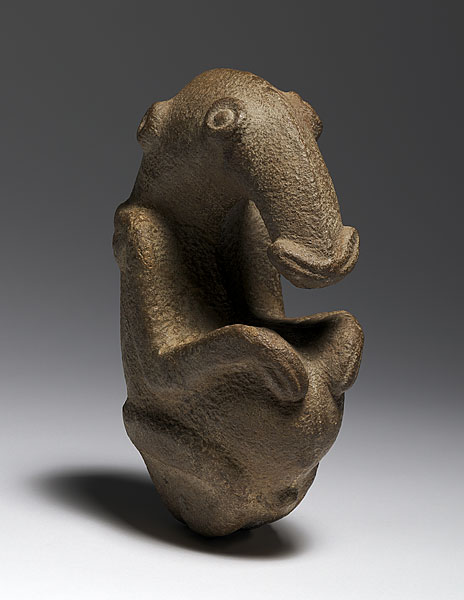
The Ambum Stone
1500 BCE
Unknown artist/culture
Greywacke
Ambum Valley, Enga Province, Papua New Guinea
Context: Civilization believed in souls and importance of ancestors
Content: Incised arms and features, identified as anteater,
Function: Unknown, possibly ritual object
1500 BCE
Unknown artist/culture
Greywacke
Ambum Valley, Enga Province, Papua New Guinea
Context: Civilization believed in souls and importance of ancestors
Content: Incised arms and features, identified as anteater,
Function: Unknown, possibly ritual object
18
New cards

Temple of Amun-Re and Hypostyle Hall
1473 BCE
New Kingdom, 18th Dynasty
Cut sandstone and mudbrick
Near Luxor, Egypt
Context: painted and carved to please the gods
Content: over 100 columns (to represent papyrus plants and flowers), statue of Amun Re is sacred and god of gods, each pharoah adds a different pylon, includes preists quarters, learning centers and shops, once supported a stone roof, post and lintel technique before the arch
Function: Religious structure, not for public only royal, priests and gods
1473 BCE
New Kingdom, 18th Dynasty
Cut sandstone and mudbrick
Near Luxor, Egypt
Context: painted and carved to please the gods
Content: over 100 columns (to represent papyrus plants and flowers), statue of Amun Re is sacred and god of gods, each pharoah adds a different pylon, includes preists quarters, learning centers and shops, once supported a stone roof, post and lintel technique before the arch
Function: Religious structure, not for public only royal, priests and gods
19
New cards

Mortuary Temple of Hatshepsut
1473 BCE
New Kingdom, 18th Dynasty
Sandstone, partially carved into rock cliff, red granite
Near Luxor Egypt
Context: Hatshepsut was woman with authority of pharaoh, created her own, built against cliff face (gives permanence),
Content: Kneeling figures represent Hatshepsut as a sphinx with royal symbols (beard, head cloth),
Function: Mortuary temple used for rituals, asserts Hatshepsut’s authority
1473 BCE
New Kingdom, 18th Dynasty
Sandstone, partially carved into rock cliff, red granite
Near Luxor Egypt
Context: Hatshepsut was woman with authority of pharaoh, created her own, built against cliff face (gives permanence),
Content: Kneeling figures represent Hatshepsut as a sphinx with royal symbols (beard, head cloth),
Function: Mortuary temple used for rituals, asserts Hatshepsut’s authority
20
New cards

Akhenaton, Nefertiti and their Three Daughters
1353 BCE
New Kingdom, 18th Dynasty
Limestone
Amarna, Egypt
Context: Akhenaton believed in ONLY Aten/the sun god, Nefertiti ruled by his side
Content: Hierarchal scale shows the two figures as same height so similar power, sun represents sun god reaching to royals, naturalistic because of realistic proportions like wide hips and stomachs, composite figures, stylized because very rounded and overall proportions aren’t naturalistic, uses compositional skills, hieroglyphics
Function: Heiroglyphics record Akhenaton, Nefertiti and their three daughters and the scene
1353 BCE
New Kingdom, 18th Dynasty
Limestone
Amarna, Egypt
Context: Akhenaton believed in ONLY Aten/the sun god, Nefertiti ruled by his side
Content: Hierarchal scale shows the two figures as same height so similar power, sun represents sun god reaching to royals, naturalistic because of realistic proportions like wide hips and stomachs, composite figures, stylized because very rounded and overall proportions aren’t naturalistic, uses compositional skills, hieroglyphics
Function: Heiroglyphics record Akhenaton, Nefertiti and their three daughters and the scene
21
New cards

Tutankhamun’s tomb (innermost coffin)
1323 BCE
New Kingdom, 18th Dynasty
Solid gold with inlay of enamel and semiprecious stones (lapis, turquoise, etc)
Luxor, Egypt
Context: Only royal tomb found relatively intact, pharoah = god or divine
Content: Wings of isis, crook and flail were royal symbols, gold represents sun, many symbols of gods/goddesses to show his divine form and divine right to rule
Function: to hold/preserve/protect body through the afterlife
1323 BCE
New Kingdom, 18th Dynasty
Solid gold with inlay of enamel and semiprecious stones (lapis, turquoise, etc)
Luxor, Egypt
Context: Only royal tomb found relatively intact, pharoah = god or divine
Content: Wings of isis, crook and flail were royal symbols, gold represents sun, many symbols of gods/goddesses to show his divine form and divine right to rule
Function: to hold/preserve/protect body through the afterlife
22
New cards

Last Judgement of Hu-nefer (from Book of the Dead)
1275 BCE
New Kingdom, 18th Dynasty
Painted Papyrus Scroll
Thebes, Egypt
Context: Hunefer was a scribe, scribe was a respected job
Content: Continuous narrative, shows a narrative through people being repeated in many scenes, depicts many gods and dieties, composite figures, hieroglyphs
Function: To be buried with the person to lead them through the afterlife
1275 BCE
New Kingdom, 18th Dynasty
Painted Papyrus Scroll
Thebes, Egypt
Context: Hunefer was a scribe, scribe was a respected job
Content: Continuous narrative, shows a narrative through people being repeated in many scenes, depicts many gods and dieties, composite figures, hieroglyphs
Function: To be buried with the person to lead them through the afterlife
23
New cards

Tlalico female figurine
1200-900 BCE
Tlatico peoples
Ceramic
Central Mexico
Context: Found in graves, multiple similar figurines were found with a variety of headdresses
Content: Hair is made of different clay using a tool for texture, wide hips, pinched waist, shows that region had a style/culture, lively/intimate poses and expressions
Function: Unknown
1200-900 BCE
Tlatico peoples
Ceramic
Central Mexico
Context: Found in graves, multiple similar figurines were found with a variety of headdresses
Content: Hair is made of different clay using a tool for texture, wide hips, pinched waist, shows that region had a style/culture, lively/intimate poses and expressions
Function: Unknown
24
New cards

Terra Cotta fragment
1000 BCE
Lapita people
Incised terracotta
Solomon Islands, Remote Oceana (East of Australia)
Context: Found all over set of islands
Content: Fragments of pottery, shows development in pacific style, complex, decorative symbols like hashes and circles = “design grammar”
Function: Used to follow migration/trade routes of Lapita people
1000 BCE
Lapita people
Incised terracotta
Solomon Islands, Remote Oceana (East of Australia)
Context: Found all over set of islands
Content: Fragments of pottery, shows development in pacific style, complex, decorative symbols like hashes and circles = “design grammar”
Function: Used to follow migration/trade routes of Lapita people
25
New cards

Chavin de Huantar
900-500 BCE
Chavin people
Stone (archetecture), granite (lanzon+sculpture), hammered gold alloy (jewelry)
Northern Highlands, Peru
Context: Remote in islands, built in phases, lanzon = notched wedged shaped stone, jaguar is symbol of power,
Content: Lanzon has face with big eyes+teeth+claws+human+animal+jaguar+curvelinear style+ composite figure+one hand up/down for sky and earth, built to hear whistling sounds through the channels, inside has inner maze to sanctum,
Function: Religious/sacred complex
900-500 BCE
Chavin people
Stone (archetecture), granite (lanzon+sculpture), hammered gold alloy (jewelry)
Northern Highlands, Peru
Context: Remote in islands, built in phases, lanzon = notched wedged shaped stone, jaguar is symbol of power,
Content: Lanzon has face with big eyes+teeth+claws+human+animal+jaguar+curvelinear style+ composite figure+one hand up/down for sky and earth, built to hear whistling sounds through the channels, inside has inner maze to sanctum,
Function: Religious/sacred complex
26
New cards

Lamassu from the Citadel of Sargon II
720 BCE
Neo-Assyrian
Alabaster
Dur Sharrrukin, Iraq (near East)
Context: War was common in area because limited resources, Assyrian rule was violent and authoritative, figures at gates,
Content: Walls around have reliefs of war/peace, Lamassu figures are strong/solid/rigid/upright, wears horned crown of divinity and beard = power, walking and moving, cuneiform script has dedications to king from gods, human + bull/lion to show strength, faces styled after kings,
Function: Guardian figures, show authority
720 BCE
Neo-Assyrian
Alabaster
Dur Sharrrukin, Iraq (near East)
Context: War was common in area because limited resources, Assyrian rule was violent and authoritative, figures at gates,
Content: Walls around have reliefs of war/peace, Lamassu figures are strong/solid/rigid/upright, wears horned crown of divinity and beard = power, walking and moving, cuneiform script has dedications to king from gods, human + bull/lion to show strength, faces styled after kings,
Function: Guardian figures, show authority
27
New cards

Athenian Agora
600 BCE
Archaic+Classical+Hellenistic Greek
Marble (architecture), plan/layout
Athens, Greece
Context: Kings were patrons, at heart of city
Content: One of earliest examples of secular architecture
Function: Yearly ritual from Agora to Acropolis, secular space for men to meet and “pursuit of the mind” AKA daily life, contains temple of Hepthestis
600 BCE
Archaic+Classical+Hellenistic Greek
Marble (architecture), plan/layout
Athens, Greece
Context: Kings were patrons, at heart of city
Content: One of earliest examples of secular architecture
Function: Yearly ritual from Agora to Acropolis, secular space for men to meet and “pursuit of the mind” AKA daily life, contains temple of Hepthestis
28
New cards
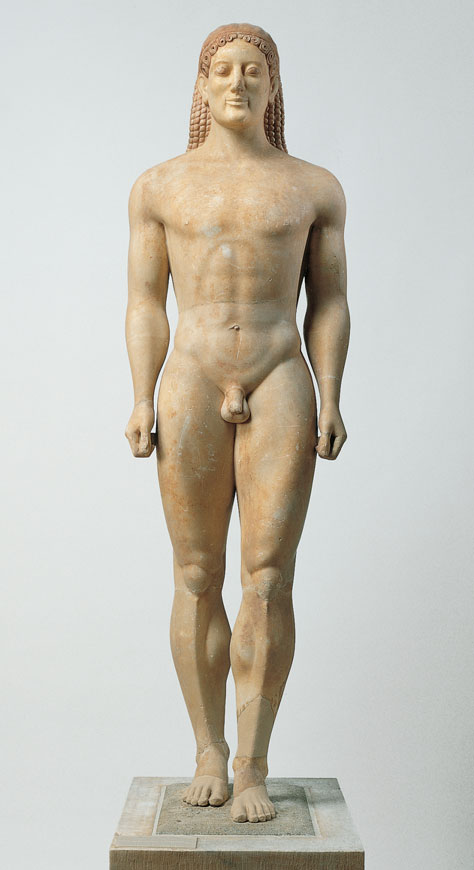
Anavysos Kouros
530 BCE
Archaic Greek
Marble with remnants of paint
Attica, Greece
Context: Had influence from Egyptians because of trade,
Content: Free standing, generic statue to represent the ideal male form, “heroic nudity”, stiff, blocky, traditional hair braiding, archaic smile, not specific depiction of a person/individualistic
Function: Funerary statue (of noble son who died in war)
530 BCE
Archaic Greek
Marble with remnants of paint
Attica, Greece
Context: Had influence from Egyptians because of trade,
Content: Free standing, generic statue to represent the ideal male form, “heroic nudity”, stiff, blocky, traditional hair braiding, archaic smile, not specific depiction of a person/individualistic
Function: Funerary statue (of noble son who died in war)
29
New cards

Peplos Kore from the Acropolis
530 BCE
Archaic Greek
Marble with painted details
Athens, Greece
Context: Shows linear improvement from Anavysos Kore because its more naturalistic + has better proportions + marble is more “fleshy”, used to be painted
Content: Wearing peplos which is a rectangle cloth pinned at shoulders, representative of female youth, females in Greece were not nude until Hellenistic period, muffin top shows more naturalism, draping hair,
Function: Either offerings to god or POSSIBLY depiction of god
530 BCE
Archaic Greek
Marble with painted details
Athens, Greece
Context: Shows linear improvement from Anavysos Kore because its more naturalistic + has better proportions + marble is more “fleshy”, used to be painted
Content: Wearing peplos which is a rectangle cloth pinned at shoulders, representative of female youth, females in Greece were not nude until Hellenistic period, muffin top shows more naturalism, draping hair,
Function: Either offerings to god or POSSIBLY depiction of god
30
New cards

Sarcophagus of the Spouses
520 BCE
Etruscan
Terra cotta
Cerveteri, Italy
Context: Etruscans and Greeks influenced eachother (see archaic smile), terra cotta is additive sculpture,
Content: Husband and wife being immortalized in afterlife, preserves youth through afterlife (very smooth features), they are eating/lounging/dining and interacting with viewer, stylized but still naturalistic, angular features, almond eyes, still unique to individual person, hair drapery emphasize form, has fully finished back of sculpture out of concern for the afterlife
Function: Holds ashes
520 BCE
Etruscan
Terra cotta
Cerveteri, Italy
Context: Etruscans and Greeks influenced eachother (see archaic smile), terra cotta is additive sculpture,
Content: Husband and wife being immortalized in afterlife, preserves youth through afterlife (very smooth features), they are eating/lounging/dining and interacting with viewer, stylized but still naturalistic, angular features, almond eyes, still unique to individual person, hair drapery emphasize form, has fully finished back of sculpture out of concern for the afterlife
Function: Holds ashes
31
New cards

Audience Hall of Darius and Xerxes
520 - 465 BCE
Persian (=Archaemenid Empire)
Limestone
Persopolis, Iran
Context: Archaemenid Empire was large and didn’t rule with intimidation,
Content: Contains Lamassu sculptures, bull capitals with rosettes (bull=strength/fertility/life), reliefs depict subjugated ambassadors and vassals bringing tributes in processions, military, bulls and lionesses fighting
Function: Show authority of king
520 - 465 BCE
Persian (=Archaemenid Empire)
Limestone
Persopolis, Iran
Context: Archaemenid Empire was large and didn’t rule with intimidation,
Content: Contains Lamassu sculptures, bull capitals with rosettes (bull=strength/fertility/life), reliefs depict subjugated ambassadors and vassals bringing tributes in processions, military, bulls and lionesses fighting
Function: Show authority of king
32
New cards

Temple of Minerva and Sculpture of Apollo
510 BCE
Etruscan
Wood (original temple), mud brick, tufa (volcanic rock), terra cotta
Assissi, Italy
Context: info gotten from Vetruvius’s writing, influenced by Greek but made of terra cotta to allow for more sculptural expression
Content:Temple has tuscan order (rounded column, simple disk capital, influenced roman design), decorated roof (acroteria/figures on roof), pitched roof makes rain drain better. Sculpture has drapery to emphasize striding leg, stylized, almost geometric, archaic smile, braids emphasize shoulder
Function: Worship
510 BCE
Etruscan
Wood (original temple), mud brick, tufa (volcanic rock), terra cotta
Assissi, Italy
Context: info gotten from Vetruvius’s writing, influenced by Greek but made of terra cotta to allow for more sculptural expression
Content:Temple has tuscan order (rounded column, simple disk capital, influenced roman design), decorated roof (acroteria/figures on roof), pitched roof makes rain drain better. Sculpture has drapery to emphasize striding leg, stylized, almost geometric, archaic smile, braids emphasize shoulder
Function: Worship
33
New cards

Tomb of the Triclinium
480 BCE
Etruscan
Tufa (volcanic rock) and fresco
Tarquinia, Italy
Context: Triclinium = 3 couch dining room, women were expected to stay inside (pale) and men work outside (tan), Etruscan funerals were festive to share a final meal with deceased before afterlife, ceiling (lozenge) pattern imitates fabric tent
Content: Single chamber with fresco wall decor, depicts banquet/dinner party with dancers and musicians, each (of 3) couch has 1 girl+1 boy+attendants, girls were pale (gender typing), registers
Function: to contain remains of deceased and offerings, served to reinforce social/political status with visual reminders
480 BCE
Etruscan
Tufa (volcanic rock) and fresco
Tarquinia, Italy
Context: Triclinium = 3 couch dining room, women were expected to stay inside (pale) and men work outside (tan), Etruscan funerals were festive to share a final meal with deceased before afterlife, ceiling (lozenge) pattern imitates fabric tent
Content: Single chamber with fresco wall decor, depicts banquet/dinner party with dancers and musicians, each (of 3) couch has 1 girl+1 boy+attendants, girls were pale (gender typing), registers
Function: to contain remains of deceased and offerings, served to reinforce social/political status with visual reminders
34
New cards

Niobides Krater
450 BCE
Classical Greek
Clay, red-figure technique, with white highlights
Orvetio, Italy
Context: Red figures against black background, allows for more details, between archaic and classical, possibly related to Greek wall paintings (known from writing)
Content: Depicts story of Niobid (14 kids who she bragged about, Apollo and Artemis get revenge), Artemis distinguished by bow and arrow, Apollo by ___, illusion of space from multiple ground lines, other side depicts Heracles (club and tiger skin) on platform being asked for protection by surrounding warriors,
Function: To store water and wine (calyx krater)
450 BCE
Classical Greek
Clay, red-figure technique, with white highlights
Orvetio, Italy
Context: Red figures against black background, allows for more details, between archaic and classical, possibly related to Greek wall paintings (known from writing)
Content: Depicts story of Niobid (14 kids who she bragged about, Apollo and Artemis get revenge), Artemis distinguished by bow and arrow, Apollo by ___, illusion of space from multiple ground lines, other side depicts Heracles (club and tiger skin) on platform being asked for protection by surrounding warriors,
Function: To store water and wine (calyx krater)
35
New cards

Doryphoros
450 BCE
Classical Greek / Polykleitos
Roman copy (marble) of Greek original (bronze)
Context: Romans copied Greeks because Greek culture symbolized a desirable way of life (leisure, arts, luxury, learning), marble copies were often buried and are often a lil broken, roman started copying Greeks when started conquering in 211 BCE
Content: Standard of beauty/canon/idealized form, a beauty of proportions not elements, contrapposto (counterbalancing body and S curve), had to have supports because of brittle marble
Function: considered a “canon” as in used to be an idealed form that can be studied and replicated, focus on perfection, found in place where athletes worked out so possibly used as muscle inspo
450 BCE
Classical Greek / Polykleitos
Roman copy (marble) of Greek original (bronze)
Context: Romans copied Greeks because Greek culture symbolized a desirable way of life (leisure, arts, luxury, learning), marble copies were often buried and are often a lil broken, roman started copying Greeks when started conquering in 211 BCE
Content: Standard of beauty/canon/idealized form, a beauty of proportions not elements, contrapposto (counterbalancing body and S curve), had to have supports because of brittle marble
Function: considered a “canon” as in used to be an idealed form that can be studied and replicated, focus on perfection, found in place where athletes worked out so possibly used as muscle inspo
36
New cards
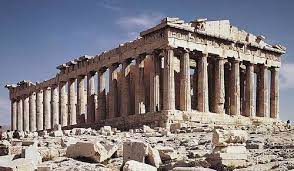
Acropolis, Iktinos and Kallikrates
447 BCE
Classical Greek
Marble
Athens, Greece
Context: Athena won over Poseidon :3 on top of hill?
Content: Temple of Athena, covered in sculptures/reliefs depicting warfare (signify ascension of Greece), wet drapery, ionic orders, contains metopes with warfare,
Function: Symbol of the birth of democracy, also religious processions, festivals
447 BCE
Classical Greek
Marble
Athens, Greece
Context: Athena won over Poseidon :3 on top of hill?
Content: Temple of Athena, covered in sculptures/reliefs depicting warfare (signify ascension of Greece), wet drapery, ionic orders, contains metopes with warfare,
Function: Symbol of the birth of democracy, also religious processions, festivals
37
New cards

Grave stele of Hegeso, Kallimachos
410 BCE
Classical Greek
Marble and paint
Athens, Greece
Context: At the time, women lived restricted lives at home, women were defined by their relationship with men
Content: Drapery closely follows and emphasizes the form, solumn and quiet mood
Function: funerary grave marker, private art (not owned/funded by the state)
410 BCE
Classical Greek
Marble and paint
Athens, Greece
Context: At the time, women lived restricted lives at home, women were defined by their relationship with men
Content: Drapery closely follows and emphasizes the form, solumn and quiet mood
Function: funerary grave marker, private art (not owned/funded by the state)
38
New cards

Treasury and Great Temple
400 BCE
Nabatean people
Cut rock
Petra, Jordon
Context: At trade center and capital, thought to contain hidden treasure,
Content: Carved into the desert, blend of cultures
Function: Royal tomb
400 BCE
Nabatean people
Cut rock
Petra, Jordon
Context: At trade center and capital, thought to contain hidden treasure,
Content: Carved into the desert, blend of cultures
Function: Royal tomb
39
New cards

Great Stupa at Sanchi
300 BCE
Maurya, late Sunga Dynasty
Stone masonry, sandstone on dome
Madhya Pradesh, India
Context: Buddism is based of meditation+nirvana+no gods just following Buddha,
Content: Gateway/torana depicts narrative scenes of local dieties to be familiar to those visiting,
Function: Buddhist ambulatory temple, meant to be walked around while meditating, represents burial mound
300 BCE
Maurya, late Sunga Dynasty
Stone masonry, sandstone on dome
Madhya Pradesh, India
Context: Buddism is based of meditation+nirvana+no gods just following Buddha,
Content: Gateway/torana depicts narrative scenes of local dieties to be familiar to those visiting,
Function: Buddhist ambulatory temple, meant to be walked around while meditating, represents burial mound
40
New cards

Terracotta Warriors from the Mausoleum of the First Qin Emperor of China
221 BCE
Qin dynasty
Painted terracotta
Mount Li, China
Context: Emperor was obsessed with immortality, he united region,
Content: All underground, also contained servants+gems+valuables+etc, each warrior face and clothes are unique/individualized,
Function: Made to protect the Emperor in the afterlife
221 BCE
Qin dynasty
Painted terracotta
Mount Li, China
Context: Emperor was obsessed with immortality, he united region,
Content: All underground, also contained servants+gems+valuables+etc, each warrior face and clothes are unique/individualized,
Function: Made to protect the Emperor in the afterlife
41
New cards

Funeral Banner of Lady Dai (Xin Zhui)
180 BCE
Han dynasty
Painted silk
Changsha, China
Context: Best preserved mummy, she was wife of a noble, also buried with other valuables, silk is expensive
Content: Narrative in registers, contains heavenly realm, attendants, body with mourners, underworld, dragon imagery, flat figures with minimal shading, more emphasis on lines, she is not idealized (chubby+handicapped) because she wasnt royalty
Function: Funerary
180 BCE
Han dynasty
Painted silk
Changsha, China
Context: Best preserved mummy, she was wife of a noble, also buried with other valuables, silk is expensive
Content: Narrative in registers, contains heavenly realm, attendants, body with mourners, underworld, dragon imagery, flat figures with minimal shading, more emphasis on lines, she is not idealized (chubby+handicapped) because she wasnt royalty
Function: Funerary
42
New cards

Winged Victory of Samothrace
175 BCE
Hellenistic Greek
Marble
Samothrace, Greece
Context: Winged Victory = Nike,
Content: Standing on tip of ship, wet drapery, more dramatic pose instead of just contrapposto,
Function: Victory monument for naval battle
175 BCE
Hellenistic Greek
Marble
Samothrace, Greece
Context: Winged Victory = Nike,
Content: Standing on tip of ship, wet drapery, more dramatic pose instead of just contrapposto,
Function: Victory monument for naval battle
43
New cards

Great Altar of Zeus and Athena at Pergamon
175 BCE
Hellenistic Greek
Marble
Asia Minor, modern Turkey
Context: Made for general of Alexander the Great, the subject is battle of Gods and Giants, has inscriptions to say who is who, fits like a pediment but in the temple
Content: Struggle is clear (faces in pain, figures in mid action), dynamic composition, intense curves of figures, deep cut drapery, naturalism, anatomic accuracy, high relief
Function: To worship at
175 BCE
Hellenistic Greek
Marble
Asia Minor, modern Turkey
Context: Made for general of Alexander the Great, the subject is battle of Gods and Giants, has inscriptions to say who is who, fits like a pediment but in the temple
Content: Struggle is clear (faces in pain, figures in mid action), dynamic composition, intense curves of figures, deep cut drapery, naturalism, anatomic accuracy, high relief
Function: To worship at
44
New cards
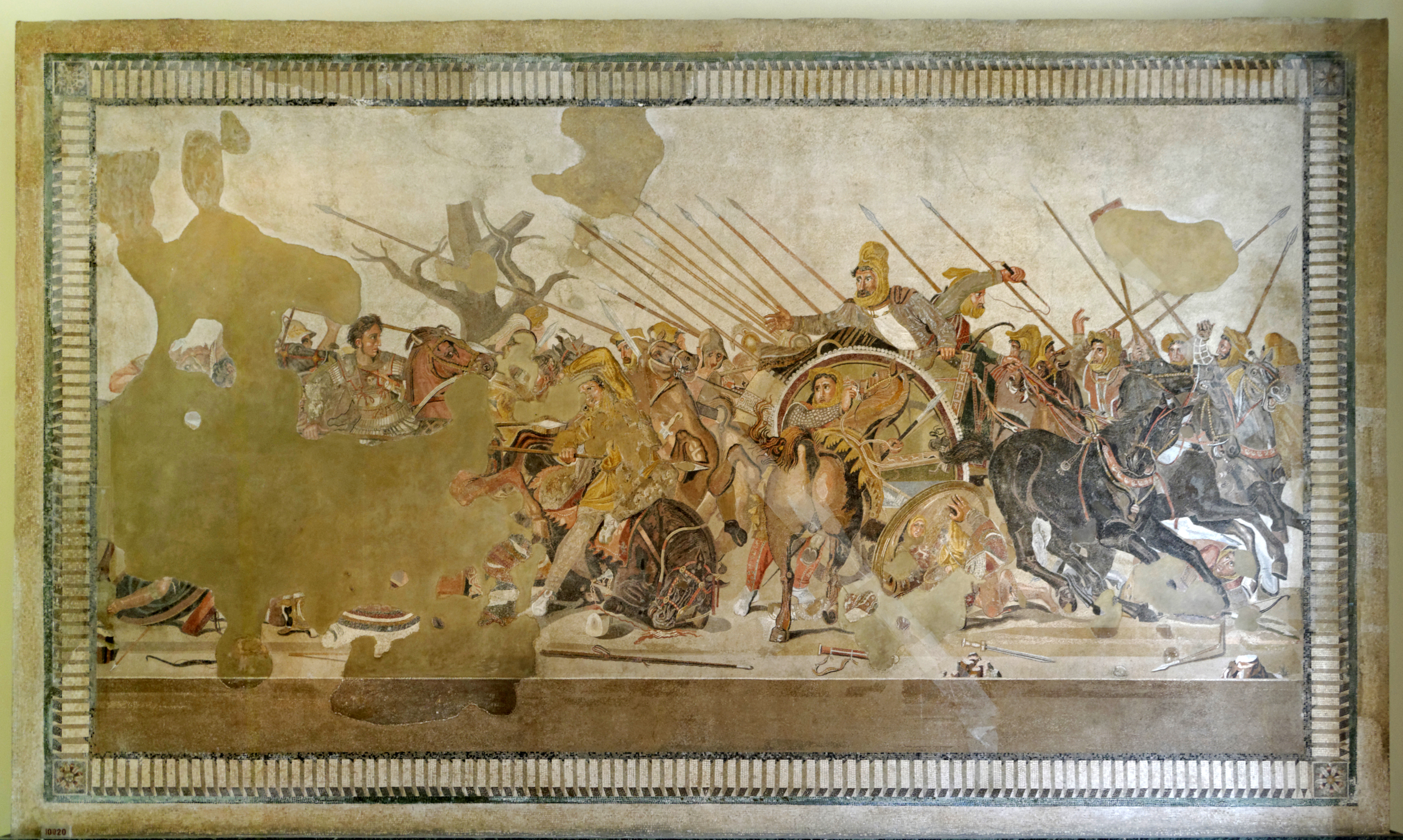
Alexander Mosaic from the House of Faun
100 BCE
Republican Roman (copy of Greek original)
Mosaic
Pompeii, Italy
Context: Recovered from volcanic ash, copy of Greek wall painting,
Content: The subject is a turning point of battle (Battle of Isis), overlap and shadows and different perspectives create depth, depth needed because no background, stylized to show determination
Function: Decor to show authority
100 BCE
Republican Roman (copy of Greek original)
Mosaic
Pompeii, Italy
Context: Recovered from volcanic ash, copy of Greek wall painting,
Content: The subject is a turning point of battle (Battle of Isis), overlap and shadows and different perspectives create depth, depth needed because no background, stylized to show determination
Function: Decor to show authority
45
New cards

Seated Boxer
100 BCE
Hellenistic Greek
Bronze
Rome, Italy
Context: Men athletes competed nude,
Content: The subject is a normal person/commoner, not idealized (beat up/bloody), idealized beard for dramaa, life like quality with incised eyes,
Function:
100 BCE
Hellenistic Greek
Bronze
Rome, Italy
Context: Men athletes competed nude,
Content: The subject is a normal person/commoner, not idealized (beat up/bloody), idealized beard for dramaa, life like quality with incised eyes,
Function:
46
New cards

Head of a Roman Patrician
75 BCE
Republican Roman
Marble
Rome, Italy
Context: Rome was a realy big empire, patrician = founder class of old roman families, romans greatly respected elders+veterans+military, uniquely roman (not Greek copy), inspired by Roman death masks (masks of deceased ancestors)
Content: Verism=a truthful depiction (sometimes highlighting real facial features), outward appearance is wise+aged+stoic+reflecting inward,
Function: Propogandistic, show “values” of society
75 BCE
Republican Roman
Marble
Rome, Italy
Context: Rome was a realy big empire, patrician = founder class of old roman families, romans greatly respected elders+veterans+military, uniquely roman (not Greek copy), inspired by Roman death masks (masks of deceased ancestors)
Content: Verism=a truthful depiction (sometimes highlighting real facial features), outward appearance is wise+aged+stoic+reflecting inward,
Function: Propogandistic, show “values” of society
47
New cards
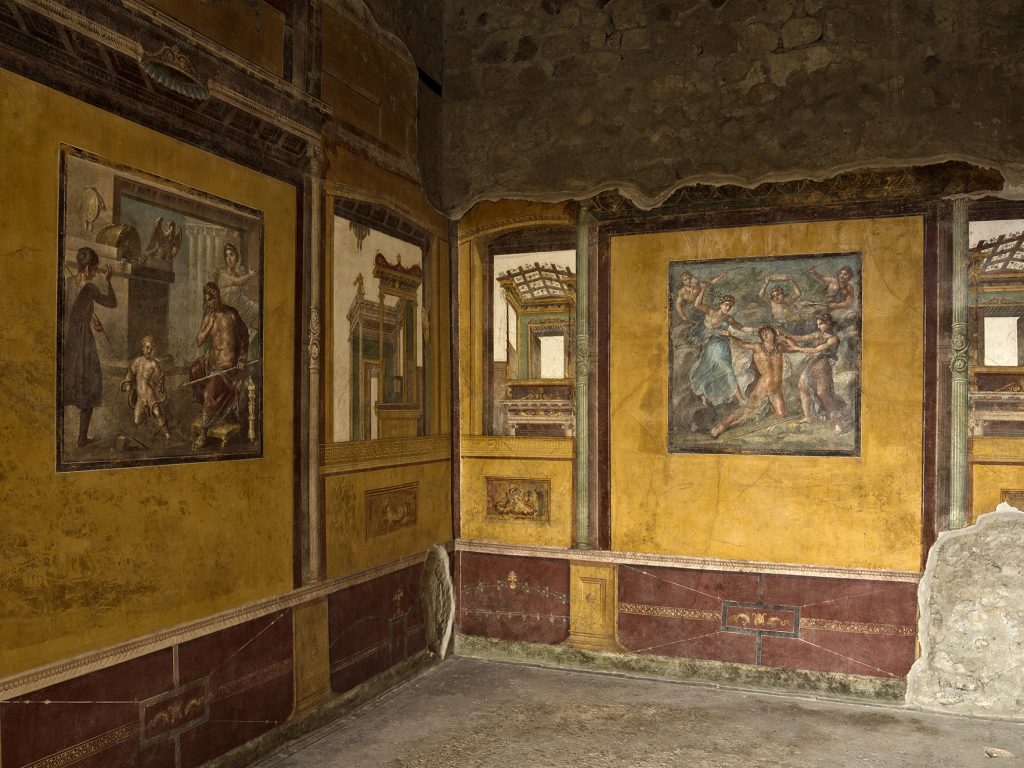
House of the Vettii
62 BCE
Imperial Roman
Cutstone and fresco (painting wet on fresco)
Pompeii, Italy
Context: Paintings in the house were inspired by Greek and illusionistic (made to make the room look bigger), had social mobility so this house was of a former slave,
Content: Walls are flat with painted on marble/columns,
Function: made to look Vettii(patron) look powerful
62 BCE
Imperial Roman
Cutstone and fresco (painting wet on fresco)
Pompeii, Italy
Context: Paintings in the house were inspired by Greek and illusionistic (made to make the room look bigger), had social mobility so this house was of a former slave,
Content: Walls are flat with painted on marble/columns,
Function: made to look Vettii(patron) look powerful
48
New cards

Augustus of Prima Porta
5 CE
Imperial Roman
Marble (painted)
Rome, Italy
Context: Julius Ceasar’s great grand nephew/heir, took power after ceasar, great reformer and builder,
Content: Roman clothing (toga/pattern), narrative on his breastplate of peaceful diplomatic event, face is portrayed accurately, hair is crab claw locks (origin from alexander the Great, common in royal portraits), youthful/smooth and a liiiil but idealized, contropposto stance, gesture is making a speech, baby is cupid, and also dolphin behind him
Function: Propoganda and to attach face to name
5 CE
Imperial Roman
Marble (painted)
Rome, Italy
Context: Julius Ceasar’s great grand nephew/heir, took power after ceasar, great reformer and builder,
Content: Roman clothing (toga/pattern), narrative on his breastplate of peaceful diplomatic event, face is portrayed accurately, hair is crab claw locks (origin from alexander the Great, common in royal portraits), youthful/smooth and a liiiil but idealized, contropposto stance, gesture is making a speech, baby is cupid, and also dolphin behind him
Function: Propoganda and to attach face to name
49
New cards

Colosseum (Flavian Ampitheater)
70 CE
Imperial Roman
Stone and concrete
Rome, Italy
Context: Named after scultpure nearby
Content: 4 different levels (bottom-rich/doric, most people/ionic, most people/ionic, women/corinthian-top), seated almost 50,000 people, could empty in 10 minutes, vaults in hallways, both decorative and efficient, oval, had cover over for shade
Function: Displayed animal fights, gladiator battles, public executions
70 CE
Imperial Roman
Stone and concrete
Rome, Italy
Context: Named after scultpure nearby
Content: 4 different levels (bottom-rich/doric, most people/ionic, most people/ionic, women/corinthian-top), seated almost 50,000 people, could empty in 10 minutes, vaults in hallways, both decorative and efficient, oval, had cover over for shade
Function: Displayed animal fights, gladiator battles, public executions
50
New cards

Forum of Trajan, markets and column
106 CE
Imperial Roman (Apollodorus of Damascus sculpture)
Bricks and concrete (architecture), Marble (column)
Rome, Italy
Context: Agora=secular and sacred, influental on Christian architecture, trajan expanded empire to furthest extent, market designed to fit irregular space, goods from all trade routes
Content: Market was multistory, crossvaults and vaults, forum had view of whole city from inside, continous narrative wraps around (Battle of Geisha), relief, chronological, detailed, shows military uniform and fighting style, has standards (like Ur), shows both military and logistical parts
Function: Market was secular and sacred for trade, forum commemorated military victory
106 CE
Imperial Roman (Apollodorus of Damascus sculpture)
Bricks and concrete (architecture), Marble (column)
Rome, Italy
Context: Agora=secular and sacred, influental on Christian architecture, trajan expanded empire to furthest extent, market designed to fit irregular space, goods from all trade routes
Content: Market was multistory, crossvaults and vaults, forum had view of whole city from inside, continous narrative wraps around (Battle of Geisha), relief, chronological, detailed, shows military uniform and fighting style, has standards (like Ur), shows both military and logistical parts
Function: Market was secular and sacred for trade, forum commemorated military victory
51
New cards

Pantheon
118 CE
Imperial Roman
Concrete with stone facing
Rome, Italy
Context: Concrete needs aggregate (something to bind around), may have been designed by Emperor, built originally to hide round roof, sponsered by Marcus Agrippa, materials imported from all over empire, CONNCCREEETEE
Content: Walls are thick and dome is thinner at top to support dome weight, corinthian temple, coffers in ceiling (make roof less heavy and breaks up smooth ceiling, makes appearance of Heavens), Oculus = hole in ceiling for lighting on main altar, lots of decor with square/circle (heaven/earth) motifs, built on human scale so when you step inside you can see all of it
Function: Temple dedicated to all gods
118 CE
Imperial Roman
Concrete with stone facing
Rome, Italy
Context: Concrete needs aggregate (something to bind around), may have been designed by Emperor, built originally to hide round roof, sponsered by Marcus Agrippa, materials imported from all over empire, CONNCCREEETEE
Content: Walls are thick and dome is thinner at top to support dome weight, corinthian temple, coffers in ceiling (make roof less heavy and breaks up smooth ceiling, makes appearance of Heavens), Oculus = hole in ceiling for lighting on main altar, lots of decor with square/circle (heaven/earth) motifs, built on human scale so when you step inside you can see all of it
Function: Temple dedicated to all gods
52
New cards

Catacomb of Priscilla
200 CE
Early Christian Europe
Excavated tufa and fresco
Rome, Italy
Context: One of earliest christian symbols, new testament christian
Content: More than 5 miles, possibly first Madonna and child (shows that cultures inspire other cultures bc Madonna isnt just Christian), Orant Fresco has gesture of prayer, roman clothes, birds represent holy trinity, fish greek symbol, similar to roman style paintings, Good Shepard Fresco, =Jesus Christ, lamb of god (sacrifices), contropposto post (artistic contiuinity), possibly setting of earliest last supper drawing and eucharist, meant to eat inside
Function: underground carved structure to house dead bodies
200 CE
Early Christian Europe
Excavated tufa and fresco
Rome, Italy
Context: One of earliest christian symbols, new testament christian
Content: More than 5 miles, possibly first Madonna and child (shows that cultures inspire other cultures bc Madonna isnt just Christian), Orant Fresco has gesture of prayer, roman clothes, birds represent holy trinity, fish greek symbol, similar to roman style paintings, Good Shepard Fresco, =Jesus Christ, lamb of god (sacrifices), contropposto post (artistic contiuinity), possibly setting of earliest last supper drawing and eucharist, meant to eat inside
Function: underground carved structure to house dead bodies
53
New cards

Ludovisi Battle Sarcophagus
250 CE
Late imperial Roman
Marble
Rome, Italy
Context: Roman empire fell 470 CE
Content: Romans vs barbarians, Romans = serious+in roman clothes/armor/bigger at top, barbarians = in pain+begging for mercy+emotional+wear pants eww+crushed at bottom, combines hellenistic (emotional/drama) and classical (naturalism), chaotic, cramped, dynamic, bent and broken axis, hierarchical scale for person in middle, although no enviornmental depth it still does have angles and overlap to show depth, high relief, movement
Function: Coffin
250 CE
Late imperial Roman
Marble
Rome, Italy
Context: Roman empire fell 470 CE
Content: Romans vs barbarians, Romans = serious+in roman clothes/armor/bigger at top, barbarians = in pain+begging for mercy+emotional+wear pants eww+crushed at bottom, combines hellenistic (emotional/drama) and classical (naturalism), chaotic, cramped, dynamic, bent and broken axis, hierarchical scale for person in middle, although no enviornmental depth it still does have angles and overlap to show depth, high relief, movement
Function: Coffin
54
New cards

Buddha
400-800 CE
Gandharan
Cut rock with plaster and polychrome paint
Bamiyan, Afghanistan
Context: Bamiyan Valley is a buddhist kingdom, on silk road (trade), destroyed 2001 by Taliban,
Content: 2 statues east and west, made as a relief, feet cut round to walk around, flowing drapery, depicts both Buddhas (celestial/historical),
Function: meant to circumambulate around feet while meditating
400-800 CE
Gandharan
Cut rock with plaster and polychrome paint
Bamiyan, Afghanistan
Context: Bamiyan Valley is a buddhist kingdom, on silk road (trade), destroyed 2001 by Taliban,
Content: 2 statues east and west, made as a relief, feet cut round to walk around, flowing drapery, depicts both Buddhas (celestial/historical),
Function: meant to circumambulate around feet while meditating
55
New cards

Santa Sabina
422-432 CE
Late Antique Europe
Brick and stone, wooden roof
Rome, Italy
Context: Building went from Roman to Christian, but building has Roman influence, based on roman basilica (long hall building) of Trojans Forum, unlike Roman DOESNT have hemicircle front and less columns, but like Roman because column fluting and corinthian
Content: focuses on longer hallway (axial), basilica (long building), very little exterior decor, flat ceiling (over time architecture has vaulted ceilings), christian architecture gets taller over time and gets rid of heavy weight, hallway leads to apse/altar, central space = nave, opened up space lets in light (heavenly oooooh)
Function: Dedicated to Saint Sabina, worship
422-432 CE
Late Antique Europe
Brick and stone, wooden roof
Rome, Italy
Context: Building went from Roman to Christian, but building has Roman influence, based on roman basilica (long hall building) of Trojans Forum, unlike Roman DOESNT have hemicircle front and less columns, but like Roman because column fluting and corinthian
Content: focuses on longer hallway (axial), basilica (long building), very little exterior decor, flat ceiling (over time architecture has vaulted ceilings), christian architecture gets taller over time and gets rid of heavy weight, hallway leads to apse/altar, central space = nave, opened up space lets in light (heavenly oooooh)
Function: Dedicated to Saint Sabina, worship
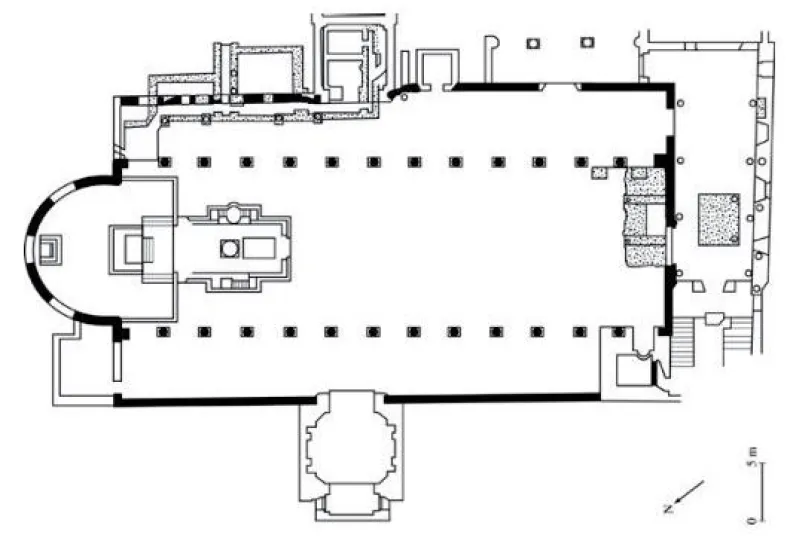
56
New cards

Mesa Verde cliff dwellings
450 CE
Ancestral Pueblan (formerly Anasazi)
Sandstone (mortar and dressed stones)
Montezuma County, Colarado
Context: abandoned in 1300 CE, on face of sheer cliff and accessed by ladders
Content: has Kivas (pits) with wooden roofs and firepits and vents and deflectors and seating places = ceremonial and residential, murals are very geometric and represent animals/plants,
Function: homes, high on cliff for protection, winter its in sun for warmth but summer its in shade for coolness
450 CE
Ancestral Pueblan (formerly Anasazi)
Sandstone (mortar and dressed stones)
Montezuma County, Colarado
Context: abandoned in 1300 CE, on face of sheer cliff and accessed by ladders
Content: has Kivas (pits) with wooden roofs and firepits and vents and deflectors and seating places = ceremonial and residential, murals are very geometric and represent animals/plants,
Function: homes, high on cliff for protection, winter its in sun for warmth but summer its in shade for coolness
57
New cards

Longmen Caves
493 - 1127 CE
Tang Dynasty
Limestone
Luoyang, China
Context: Tang dynasty = age of Buddhism,
Content: Used local chinese styles (carving+reliefs), figures are both stylistic and naturalistic, depicts Buddha and celestial/heavenly figures, mudra = hand gestures,
Function: Establish authority through religion
493 - 1127 CE
Tang Dynasty
Limestone
Luoyang, China
Context: Tang dynasty = age of Buddhism,
Content: Used local chinese styles (carving+reliefs), figures are both stylistic and naturalistic, depicts Buddha and celestial/heavenly figures, mudra = hand gestures,
Function: Establish authority through religion
58
New cards

Gold and Jade Crown
550 CE
Three Kingdoms Period, Silla Kingdom
Metalwork
Silla Kingdom, Korea
Content: Found in burial site, Silla Kingdom was on silk road so had influence and was influenced, __Shamanism__ = worships nature,
Context: Axis mundi = meeting of celestial and physical world, center part is tree of life, disks are fruit of life, bottom has “antlers”? reference to native deer,
Function: Represents a connection to the celestial world for burial and rituals
550 CE
Three Kingdoms Period, Silla Kingdom
Metalwork
Silla Kingdom, Korea
Content: Found in burial site, Silla Kingdom was on silk road so had influence and was influenced, __Shamanism__ = worships nature,
Context: Axis mundi = meeting of celestial and physical world, center part is tree of life, disks are fruit of life, bottom has “antlers”? reference to native deer,
Function: Represents a connection to the celestial world for burial and rituals
59
New cards
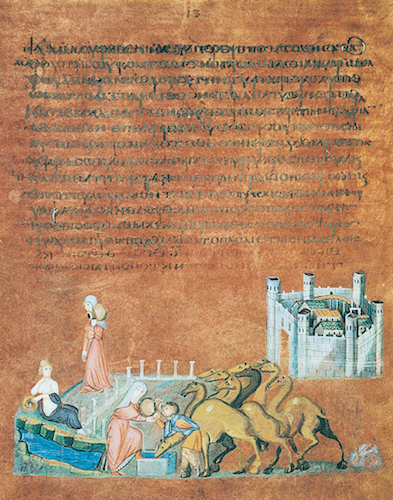
Rebecca and Eliezer at the Well / Jacob Wrestling the Angel FROM the Vienna Genesis
early 6th century CE
Early Byzantine Europe/east Roman
Illuminated manuscript (tempera, gold, silver on purple vellum)
Europe
Context: Monks would travel and copy writing, shows transition from classical to medieval (naturalism focusing on volume rendering towards stylized and representational),
Content: Continuous narrative, written in Greek by hand on animal skin (expensive, wealth was symbolic of divine/holy), illumination = colorful drawings a if light shone through stained glass, genesis = 1st book of bible,
Function: to be read out/educational
early 6th century CE
Early Byzantine Europe/east Roman
Illuminated manuscript (tempera, gold, silver on purple vellum)
Europe
Context: Monks would travel and copy writing, shows transition from classical to medieval (naturalism focusing on volume rendering towards stylized and representational),
Content: Continuous narrative, written in Greek by hand on animal skin (expensive, wealth was symbolic of divine/holy), illumination = colorful drawings a if light shone through stained glass, genesis = 1st book of bible,
Function: to be read out/educational
60
New cards

San Vitale
526-547 CE
Early Byzantine Europe (Romans after Rome)
Brick, marble and stone veneer, mosaic
Ravenna, Italy
Context: commissioned by Justinian,
Content: octagon shape (transitioning away from cross shape) means central plan, contains many mosaics, exterior supports radiate out so that light can go in through windows (heavenly), many niches and half domes and windows, columns show classical inspiration
CONTAINS JUSTINIAN + THEODORA PANELS:
shows hierarchy, halo = divine authority, shows churches support of royals, shows religious authority, women outside because no women in mass, their entourage shows how much support hey have (compare to Code of Hammurabi)
Function: Worship and show Justinian’s authority
526-547 CE
Early Byzantine Europe (Romans after Rome)
Brick, marble and stone veneer, mosaic
Ravenna, Italy
Context: commissioned by Justinian,
Content: octagon shape (transitioning away from cross shape) means central plan, contains many mosaics, exterior supports radiate out so that light can go in through windows (heavenly), many niches and half domes and windows, columns show classical inspiration
CONTAINS JUSTINIAN + THEODORA PANELS:
shows hierarchy, halo = divine authority, shows churches support of royals, shows religious authority, women outside because no women in mass, their entourage shows how much support hey have (compare to Code of Hammurabi)
Function: Worship and show Justinian’s authority

61
New cards

Hagia Sophia
532 - 537 CE
Byzantine (Anthemius of Tralles and Isadorus of Miletus)
Brick and ceramic elements, stone and mosaic veneer
Constantinople (Istanbul)
Context: Still Justinian patron, originally Christian then turned Islamic (later added minerets), Hagia Sophia name = Holy Wisdom,
Content: Dome with windows on bottom appears to be held up by divine intervention/floating, columns inspired by ionic and byzantine, dome on arches instead of squinches/corners, central plan, later added calligraphy for islam
Function: place of worship, originally showed Byzantines authority
532 - 537 CE
Byzantine (Anthemius of Tralles and Isadorus of Miletus)
Brick and ceramic elements, stone and mosaic veneer
Constantinople (Istanbul)
Context: Still Justinian patron, originally Christian then turned Islamic (later added minerets), Hagia Sophia name = Holy Wisdom,
Content: Dome with windows on bottom appears to be held up by divine intervention/floating, columns inspired by ionic and byzantine, dome on arches instead of squinches/corners, central plan, later added calligraphy for islam
Function: place of worship, originally showed Byzantines authority
62
New cards

Merovingian (Frankish) looped fibulae (clasps)
mid 500 CE
Early medieval Europe
Silver gilt worked in filigree with inlays of garnet and other stones, gold
France
Context: VERY OLD FRANCE (dark ages???), Barbarian = anyone at time of Romans who weren’t roman, near beginning of Christianity,
Content: Filigree = delicate metalwork with silver/gold wire, cloisonne = flat wire sat on side with glass/stones put it and made smooth, cross and fish are religious symbols of Christianity, more symbolism is suns/bird heads,
Function: Decorative clasp (luxury item), found in burial site
mid 500 CE
Early medieval Europe
Silver gilt worked in filigree with inlays of garnet and other stones, gold
France
Context: VERY OLD FRANCE (dark ages???), Barbarian = anyone at time of Romans who weren’t roman, near beginning of Christianity,
Content: Filigree = delicate metalwork with silver/gold wire, cloisonne = flat wire sat on side with glass/stones put it and made smooth, cross and fish are religious symbols of Christianity, more symbolism is suns/bird heads,
Function: Decorative clasp (luxury item), found in burial site
63
New cards

Virgin (Theotokos) and Child between saints Theodore and George
600 CE
Early Byzantine Europe
Encaustic on wood
Egypt
Context: Mother and child composition is seen all throughout time,
Content: Icon = depictions of religious figures used for prayer and connection to divine and earthy manifestation and often found in churches, encaustic = hot wax used to color pigment and wax (quick drying and very permanent), very stylized with roundness and 3D form (similar to Justinian mosaic), individualized and rounded faces (large eyes big in byzantine style, sad and serene faces, hierarchal balanced composition, architecture in background to give illusion of space, hand of god at top
Function: At place of worship to be used in worship
600 CE
Early Byzantine Europe
Encaustic on wood
Egypt
Context: Mother and child composition is seen all throughout time,
Content: Icon = depictions of religious figures used for prayer and connection to divine and earthy manifestation and often found in churches, encaustic = hot wax used to color pigment and wax (quick drying and very permanent), very stylized with roundness and 3D form (similar to Justinian mosaic), individualized and rounded faces (large eyes big in byzantine style, sad and serene faces, hierarchal balanced composition, architecture in background to give illusion of space, hand of god at top
Function: At place of worship to be used in worship
64
New cards

The Kaaba
631 CE
Islamic
Granite masonry covered with silk curtain and calligraphy in gold and silver wrapped thread
Mecca, Saudi Arabia
Context: Jihad = “holy war” AKA internal struggle, Hajj = annual pilgrimage to Mecca, this is direction where Muslims pray to, believed to have been made by Abraham and Ismail
Content: Karan = sacred scripture, Black Stone is very sacred
Function: part of necessary pilgrimage for Islam pillars, ritual where Muslims circumambulate to touch and kiss center Black Stone (to wash away sins)
631 CE
Islamic
Granite masonry covered with silk curtain and calligraphy in gold and silver wrapped thread
Mecca, Saudi Arabia
Context: Jihad = “holy war” AKA internal struggle, Hajj = annual pilgrimage to Mecca, this is direction where Muslims pray to, believed to have been made by Abraham and Ismail
Content: Karan = sacred scripture, Black Stone is very sacred
Function: part of necessary pilgrimage for Islam pillars, ritual where Muslims circumambulate to touch and kiss center Black Stone (to wash away sins)
65
New cards

Jowo Rinpiche (Precious one)
641 CE (probably)
Yarlung Dynasty
Gilt metals with semiprecious stones, pearls and paint
Enshrined in the Joknang Temple, Lhasa Tibet
Context: Lhasa is holiest place in Buddhism, Tibet has largest population of Buddhists,
Content: Face is placid+peaceful+firm+stern+steadfast, mudra is position of hands having meaning, very ornate (common for Buddhist art), inspired by historical Buddha as opposed to classic
Function: Meant to have offerings in front, because Buddha is eternal so still needs gifts
641 CE (probably)
Yarlung Dynasty
Gilt metals with semiprecious stones, pearls and paint
Enshrined in the Joknang Temple, Lhasa Tibet
Context: Lhasa is holiest place in Buddhism, Tibet has largest population of Buddhists,
Content: Face is placid+peaceful+firm+stern+steadfast, mudra is position of hands having meaning, very ornate (common for Buddhist art), inspired by historical Buddha as opposed to classic
Function: Meant to have offerings in front, because Buddha is eternal so still needs gifts
66
New cards

Dome of the Rock
691 - 692 CE (with multiple renovations)
Islamic, Umayyad
Stone masonry and wooden roof decorated with glazed ceramic tiles, mosiacs and gilt aluminum + bronze dome
Jerusalem, Palenstine
Context: one of earliest islamic buildings,
Content: Contains calligraphy, geometric, vegetal and floral designs, rock itself is a sacred site, colonnades = rows of columns, ambulatories = aisles meant to walk through
Function: Sacred location for Muslims and Jews and Christians (for all different reasons)
691 - 692 CE (with multiple renovations)
Islamic, Umayyad
Stone masonry and wooden roof decorated with glazed ceramic tiles, mosiacs and gilt aluminum + bronze dome
Jerusalem, Palenstine
Context: one of earliest islamic buildings,
Content: Contains calligraphy, geometric, vegetal and floral designs, rock itself is a sacred site, colonnades = rows of columns, ambulatories = aisles meant to walk through
Function: Sacred location for Muslims and Jews and Christians (for all different reasons)

67
New cards

Great Mosque of Isfahan
700 CE + restorations/additions
Islamic, Persian, Timurid and Safivid dynasties
Stone, brick, wood, plaster and glazed ceramic tiles
Isfahan, Iran
Context:
Content: Minnerets are used to call people to prayer, mihrabs/domes have hypostyles (clusters of pillars) and marks Qibla (wall showing direction to Mecca) and has stucco (plaster-like material), Iwans is a vaulted space that opens to a central courtyard, bubble wrap like roof, domes and ribbed vaulting (muqarnas?), no figurative decor
Function:
700 CE + restorations/additions
Islamic, Persian, Timurid and Safivid dynasties
Stone, brick, wood, plaster and glazed ceramic tiles
Isfahan, Iran
Context:
Content: Minnerets are used to call people to prayer, mihrabs/domes have hypostyles (clusters of pillars) and marks Qibla (wall showing direction to Mecca) and has stucco (plaster-like material), Iwans is a vaulted space that opens to a central courtyard, bubble wrap like roof, domes and ribbed vaulting (muqarnas?), no figurative decor
Function:
68
New cards

Folio from a Qur’an
700 CE
Abbasid Dynasty
Ink, color and gold on parchment
Arab, North Africa or Near East
Context: possessed by wealthy people
Content: Arabic script, red and gold dots represent vowel sounds, not centered (for sacred reasons), suras = chapters, suras are marked by decorative golden registers,
Function: for worship and show of power ($$$)
700 CE
Abbasid Dynasty
Ink, color and gold on parchment
Arab, North Africa or Near East
Context: possessed by wealthy people
Content: Arabic script, red and gold dots represent vowel sounds, not centered (for sacred reasons), suras = chapters, suras are marked by decorative golden registers,
Function: for worship and show of power ($$$)
69
New cards

Lindisfarne Gospels: St Matthew cross carpet page and St luke portrait page and incipit page
700 CE
Early Medieval Europe (Hiberno Saxon)
Illuminated manuscript (Ink, pigments and gold on velum)
Northumbria, England
Context: manuscripts were popular in west because they were the only way writing could survive, monasteries were self sufficient homes for monks which contained churches and centers for learning,
Content: Written in latin (only monks could read it), crosscarpet page: interlaced birds, highly decorative ($$$), only heavily illustrated because it was a bible. Portrait page: gopels were important bc of Bible, interlaced styles with reliance on line, flat because all depth was in the lines, very traditional posing. floral and animal figures, made so expensive because it was sacred
Function: monks would read it to spread the education of the bible
700 CE
Early Medieval Europe (Hiberno Saxon)
Illuminated manuscript (Ink, pigments and gold on velum)
Northumbria, England
Context: manuscripts were popular in west because they were the only way writing could survive, monasteries were self sufficient homes for monks which contained churches and centers for learning,
Content: Written in latin (only monks could read it), crosscarpet page: interlaced birds, highly decorative ($$$), only heavily illustrated because it was a bible. Portrait page: gopels were important bc of Bible, interlaced styles with reliance on line, flat because all depth was in the lines, very traditional posing. floral and animal figures, made so expensive because it was sacred
Function: monks would read it to spread the education of the bible
70
New cards

Nan Madol
700 CE
Saudeleur Dynasty
Basalt boulders and prismatic columns (coral filled in gaps)
Pohnpei, Micronesia (off of New Zealand)
Context:
Content: 92 man made islands off the coast, basalt was carryied by people from miles away because of natural log shape and show of power, up to 50 feet tall
Function: politcal and secular and religious wooh
700 CE
Saudeleur Dynasty
Basalt boulders and prismatic columns (coral filled in gaps)
Pohnpei, Micronesia (off of New Zealand)
Context:
Content: 92 man made islands off the coast, basalt was carryied by people from miles away because of natural log shape and show of power, up to 50 feet tall
Function: politcal and secular and religious wooh
71
New cards

Yaxhilan
725 CE
Mayan
Limestone
Chiapas, Mexico
Context:
Content: Depicts lady Xoc and Lord Shield Jaguar in rituals, bloodletting, heiroglyphs say who and when, stylized and detailed, lintels were decorative and ornamental, depicts culture and religions
Function: for rituals and human sacrifices
725 CE
Mayan
Limestone
Chiapas, Mexico
Context:
Content: Depicts lady Xoc and Lord Shield Jaguar in rituals, bloodletting, heiroglyphs say who and when, stylized and detailed, lintels were decorative and ornamental, depicts culture and religions
Function: for rituals and human sacrifices

72
New cards

Todai-Ji
743 CE
Song Dynasty
Bronze and wood sculpture, wood and ceremic tile roofing for architecture
Nara, Japan
Context: Sponsored by powerful families, shows mix of Buddhism and politics, Buddhism came from silk route,
Content: Contains Buddha with mudra (welcoming), traditional/classic Buddha, serene features, large stylized complex, double roofs, sculptures are naturalism and sylized and dynamic and strong and muscley,
Function: Represents shift in political rule of Japan, establishes authority, sponsor wanted to establish place as capital
743 CE
Song Dynasty
Bronze and wood sculpture, wood and ceremic tile roofing for architecture
Nara, Japan
Context: Sponsored by powerful families, shows mix of Buddhism and politics, Buddhism came from silk route,
Content: Contains Buddha with mudra (welcoming), traditional/classic Buddha, serene features, large stylized complex, double roofs, sculptures are naturalism and sylized and dynamic and strong and muscley,
Function: Represents shift in political rule of Japan, establishes authority, sponsor wanted to establish place as capital

73
New cards

Great Mosque at Cordoba
785 CE
Umayyad Dynasty
Stone masonry
Cordoba, Spain
Context: On hill top, originally roman then christian then muslim then catholic, inspiration from Great Mosque of Isfahan
Content: Has mihrab (points to mecca), double arches and horseshoes shapes, has local styles and domes and classic islamis styles and very ornate and precious materials, ribbed vaulting, has hypostyle hall
Function: Worship, complex, librarys etc
785 CE
Umayyad Dynasty
Stone masonry
Cordoba, Spain
Context: On hill top, originally roman then christian then muslim then catholic, inspiration from Great Mosque of Isfahan
Content: Has mihrab (points to mecca), double arches and horseshoes shapes, has local styles and domes and classic islamis styles and very ornate and precious materials, ribbed vaulting, has hypostyle hall
Function: Worship, complex, librarys etc

74
New cards

Borobudur Temple
750 CE
Sailendra dynasty
volcanic stone masonry
Central Java, Indonesia
Context: influenced by Indian and Hindu art, protected site
Content: Megastructure, depicts Buddha his life and beliefs, influenced by Indian and Hindu art, meant to be circumambulated, stupa at top, 72 other stupas, overall in shape of madala (geometric design for meditation), references 3 states of conciousness to reach Nirvana, 2000+ reliefs
Function: Pilgrimage and worship
750 CE
Sailendra dynasty
volcanic stone masonry
Central Java, Indonesia
Context: influenced by Indian and Hindu art, protected site
Content: Megastructure, depicts Buddha his life and beliefs, influenced by Indian and Hindu art, meant to be circumambulated, stupa at top, 72 other stupas, overall in shape of madala (geometric design for meditation), references 3 states of conciousness to reach Nirvana, 2000+ reliefs
Function: Pilgrimage and worship

75
New cards

Angkor, the Temple of Angkor Wat, City of Angkor Thom
800 CE
Angkor Dynasty
Stone masonry, sandstone
Cambodia
Context: Largest religious structure in teh world
Content: Contains many reliefs, large symmetrical complex in mandala design, reaches upward,
Function: Originally Hindu (house of gods) turned Buddhist (place for contemplation), monument/tomb/legacy for king
800 CE
Angkor Dynasty
Stone masonry, sandstone
Cambodia
Context: Largest religious structure in teh world
Content: Contains many reliefs, large symmetrical complex in mandala design, reaches upward,
Function: Originally Hindu (house of gods) turned Buddhist (place for contemplation), monument/tomb/legacy for king
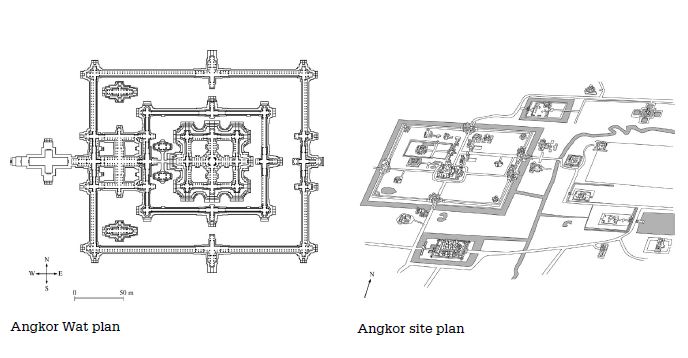
76
New cards
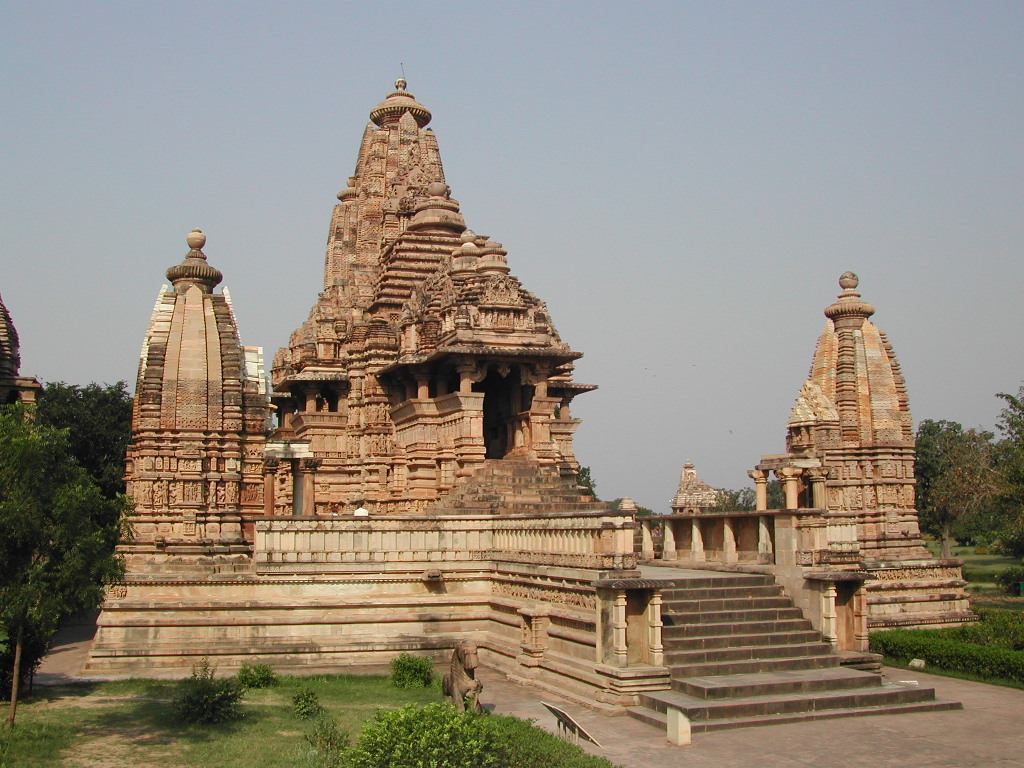
Lakshama Temple
930 CE
Chandella Dynasty
Sandstone
Khajuraho, India
Context:
Content: High reliefs, sensual and smooth and stately and elegant and calm, depicts humans and gods, niches with representations of dieties
Function: Hindu, dedicated to Vishnu, meant to be circumambulated, symbol of fertility and prospoerous future
930 CE
Chandella Dynasty
Sandstone
Khajuraho, India
Context:
Content: High reliefs, sensual and smooth and stately and elegant and calm, depicts humans and gods, niches with representations of dieties
Function: Hindu, dedicated to Vishnu, meant to be circumambulated, symbol of fertility and prospoerous future

77
New cards
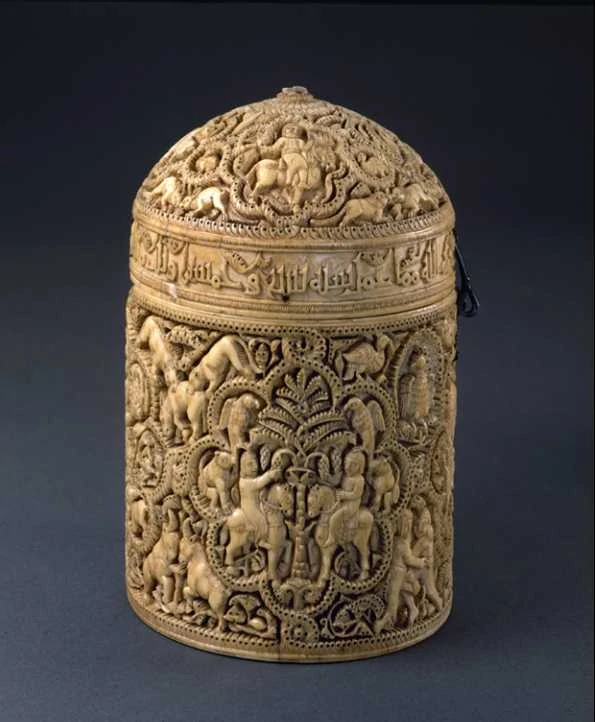
Pyxis of al-Mughira
968 CE
Umayyad dynasty
Ivory (elephant tusk)
Spain
Context: Muslim origin but secular art, coming of age present,
Content: symbolically depicts power and victory and warfare, shows animals (eagle = power, cats = food???), royal iconography,
Function: Contained perfumes, artwork shows power and $$$
968 CE
Umayyad dynasty
Ivory (elephant tusk)
Spain
Context: Muslim origin but secular art, coming of age present,
Content: symbolically depicts power and victory and warfare, shows animals (eagle = power, cats = food???), royal iconography,
Function: Contained perfumes, artwork shows power and $$$
78
New cards

Travelers among Mountains and Streams
1000 CE
Northern Song Dynasty (Artist is Fan Kuan)
Ink and colors on silk
China
Context: landscapes were popular in China, Taoism = animals and humans should live in balance with universe/Tao, neo-confucianism = a search for absolute truth and yin/yang or li/qi
Content: Multiple techniques and materials, travelers are tiny which frames them as dominated by the world, elegant and well composed
Function: shows artists spiritual smartness/ is decor
1000 CE
Northern Song Dynasty (Artist is Fan Kuan)
Ink and colors on silk
China
Context: landscapes were popular in China, Taoism = animals and humans should live in balance with universe/Tao, neo-confucianism = a search for absolute truth and yin/yang or li/qi
Content: Multiple techniques and materials, travelers are tiny which frames them as dominated by the world, elegant and well composed
Function: shows artists spiritual smartness/ is decor
79
New cards

Shiva as Lord of Dance (Nataraja)
1000 CE
Chola dynasty
Cast bronze
India
Context: Shiva balances destruction and creation, hindu dieties are meant to be carried around
Content: Mudras show meaning and movement, fancy clothes, mid dance movement, on top of enemy, well balanced, ornate, calm, similar to Lakshama temple
Function: Hindu
1000 CE
Chola dynasty
Cast bronze
India
Context: Shiva balances destruction and creation, hindu dieties are meant to be carried around
Content: Mudras show meaning and movement, fancy clothes, mid dance movement, on top of enemy, well balanced, ornate, calm, similar to Lakshama temple
Function: Hindu
80
New cards

Conical tower and circular wall of Great Zimbabwe
1000 - 1400 CE
Shona peoples
Coursed (rows) granite blocks (no mortar)
Zimbabwe, Africa
Context: Still sacred today
Content: Large stone complex, 3 main parts, tower held grain
Function: House population on trade route
1000 - 1400 CE
Shona peoples
Coursed (rows) granite blocks (no mortar)
Zimbabwe, Africa
Context: Still sacred today
Content: Large stone complex, 3 main parts, tower held grain
Function: House population on trade route
81
New cards

Bayeux tapestry
1066 - 1080 CE
English or Norman
Embroidery on linen
Romanesque Europe
Context: Likely made by anglosaxon women skilled in embroidery,
Content: Latin inscriptions, depict warfare, romanesque style (hybrid of byzantine and classical greek and hybernosaxon), similar to Trajans column in artwork is chronoligical and continous warfare campaign,
Function: commissioned by Norman guy to commemorate his brother for invading England and taking the throne, shows authority
1066 - 1080 CE
English or Norman
Embroidery on linen
Romanesque Europe
Context: Likely made by anglosaxon women skilled in embroidery,
Content: Latin inscriptions, depict warfare, romanesque style (hybrid of byzantine and classical greek and hybernosaxon), similar to Trajans column in artwork is chronoligical and continous warfare campaign,
Function: commissioned by Norman guy to commemorate his brother for invading England and taking the throne, shows authority
82
New cards

Great Serpent Mound
1070 CE
Mississippian (Native Americans)
Earthwork/effigy mound
Adams county, southern Ohio
Context: snake = spiritual
Content: 1300 feet long, lines up with solstice, NO GRAVES INSIDE IT,
Function: ???
1070 CE
Mississippian (Native Americans)
Earthwork/effigy mound
Adams county, southern Ohio
Context: snake = spiritual
Content: 1300 feet long, lines up with solstice, NO GRAVES INSIDE IT,
Function: ???
83
New cards

Moai on platform (Ahu)
1100 CE
Rapa Nui peoples
Volcanic tuff figures on a basalt base
Rapa Nui, Easter Island
Context:
Content: Figures backs are facing the water, 887 heads, very stylized and rectangular, ceremonial carvings on back
Function: Religious honoring of dead/contains souls of dead, protecting the island
1100 CE
Rapa Nui peoples
Volcanic tuff figures on a basalt base
Rapa Nui, Easter Island
Context:
Content: Figures backs are facing the water, 887 heads, very stylized and rectangular, ceremonial carvings on back
Function: Religious honoring of dead/contains souls of dead, protecting the island
84
New cards

Church of Saint Foy and Reliquary
1130 CE
Romanesque Europe
Stone (architecture), stone and paint (tympanum), gold silver gemstone, and enamel over wood (reliquary)
Conques, France
Context: Tympanum = above an entrance
Content: has a barrel-vaulted nave lined with arches on the interior.”, layout helps flow of traffic, tympanum is a relief carving warning those who walk under it of the dangers of sin, reliquary holds remains of saint,
Function: Pilgramage church
1130 CE
Romanesque Europe
Stone (architecture), stone and paint (tympanum), gold silver gemstone, and enamel over wood (reliquary)
Conques, France
Context: Tympanum = above an entrance
Content: has a barrel-vaulted nave lined with arches on the interior.”, layout helps flow of traffic, tympanum is a relief carving warning those who walk under it of the dangers of sin, reliquary holds remains of saint,
Function: Pilgramage church

85
New cards

Chatres Cathedral
1145 CE
French Gothic
Limestone, stained glass
Chatres, France
Context: power came from tunic of virgin mary,
Content: windows focus on light and geometry, very heavy so lots of vaulting and supports, 3 levels
Function: Worship also a center for learning and to live at
1145 CE
French Gothic
Limestone, stained glass
Chatres, France
Context: power came from tunic of virgin mary,
Content: windows focus on light and geometry, very heavy so lots of vaulting and supports, 3 levels
Function: Worship also a center for learning and to live at
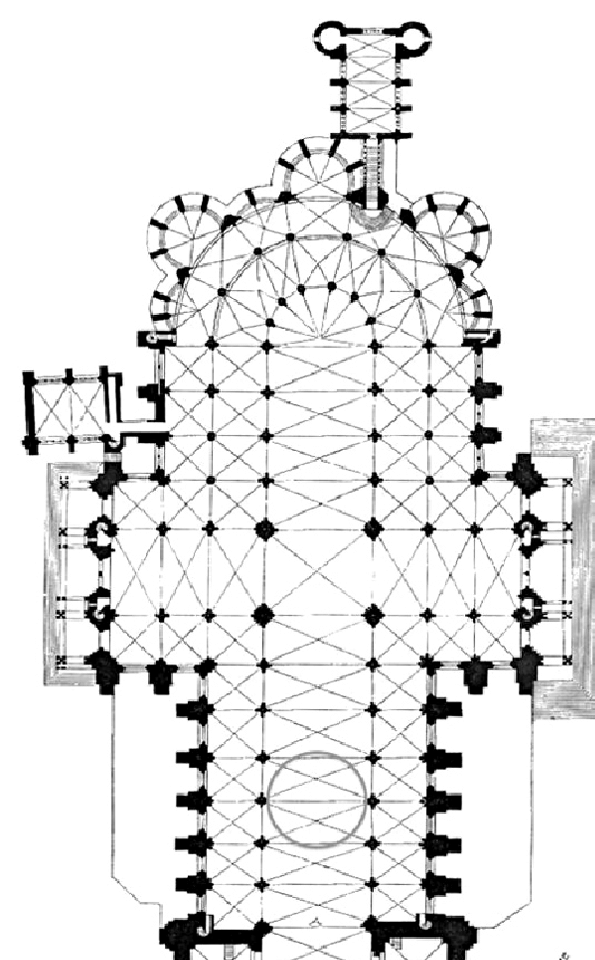
86
New cards

Dedication Page with Blanche of Castile and King Louis IX of France, Scenes from the Apocalypse from Bibles moralisees
1194 CE
Gothic Europe
Illuminated manuscript (ink, tempera and gold leaf on vellum)
Paris, France
Context: Louis IX and Blanche of Castille were rulers at time
Content: depicts monk instructing scribe and Louis, gothic = elongated and fragile style,
Function: reinforce religious ideas, made for royal houses
1194 CE
Gothic Europe
Illuminated manuscript (ink, tempera and gold leaf on vellum)
Paris, France
Context: Louis IX and Blanche of Castille were rulers at time
Content: depicts monk instructing scribe and Louis, gothic = elongated and fragile style,
Function: reinforce religious ideas, made for royal houses
87
New cards

Great Mosque of Djenne
1200 CE
Sudano-Sahelian people
Adobe and mudbrick
Mali, Africa
Context: Has to be restored by people every few years
Content: Flat roof with terra cotta lids that let in fresh air, big pillars for support, 3 minerets, ostrich eggs at top to symbolize fertility and purity, horizontal timber beams serve as support and as scaffolding for replaster event,
Function: Political symbol of power, place of worship
1200 CE
Sudano-Sahelian people
Adobe and mudbrick
Mali, Africa
Context: Has to be restored by people every few years
Content: Flat roof with terra cotta lids that let in fresh air, big pillars for support, 3 minerets, ostrich eggs at top to symbolize fertility and purity, horizontal timber beams serve as support and as scaffolding for replaster event,
Function: Political symbol of power, place of worship
88
New cards

Night Attack on the Sanjo Palace
1250 CE
Kamakura period
handscroll (ink and color on paper)
Japan
Context: hand scroll = meant to be slowly opened and read (left to right),
Content: Depicts a battle/rebellion, isometric birds eye, detailed and individualized, shows graphic violence, continuous narrative
Function: Record history from the winners side
1250 CE
Kamakura period
handscroll (ink and color on paper)
Japan
Context: hand scroll = meant to be slowly opened and read (left to right),
Content: Depicts a battle/rebellion, isometric birds eye, detailed and individualized, shows graphic violence, continuous narrative
Function: Record history from the winners side
89
New cards

Rottgen Pieta
1300 CE
German Gothic
Painted wood
Bonn, Germany
Context: Gothic style wants to invoke emotion
Content: depicts patient christ (sad, weak) as opposed to earlier depictions of triumphant christ (powerful, overcoming), shows sadness and hunger in his revealed bones and facial expression,
Function: To invoke emotion, used in worship and to feel closer to God
1300 CE
German Gothic
Painted wood
Bonn, Germany
Context: Gothic style wants to invoke emotion
Content: depicts patient christ (sad, weak) as opposed to earlier depictions of triumphant christ (powerful, overcoming), shows sadness and hunger in his revealed bones and facial expression,
Function: To invoke emotion, used in worship and to feel closer to God
90
New cards

Arena (Scrovegni) Chapel, including Lamentation (Giotto di Bondone)
1303 CE
Proto-Italian Renniescance
Brick (architecture) and fresco
Padua, Italy
Context: Giotto = made artwork comissioned by wealthy often to atone for sin,
Content: Frescos depitc lives of Mary and Christ and others, story told through images because most people couldnt read, frescoes cover walls and ceilings, continous narrative, seperated by registers, naturalism,
Function: Place of worship
1303 CE
Proto-Italian Renniescance
Brick (architecture) and fresco
Padua, Italy
Context: Giotto = made artwork comissioned by wealthy often to atone for sin,
Content: Frescos depitc lives of Mary and Christ and others, story told through images because most people couldnt read, frescoes cover walls and ceilings, continous narrative, seperated by registers, naturalism,
Function: Place of worship
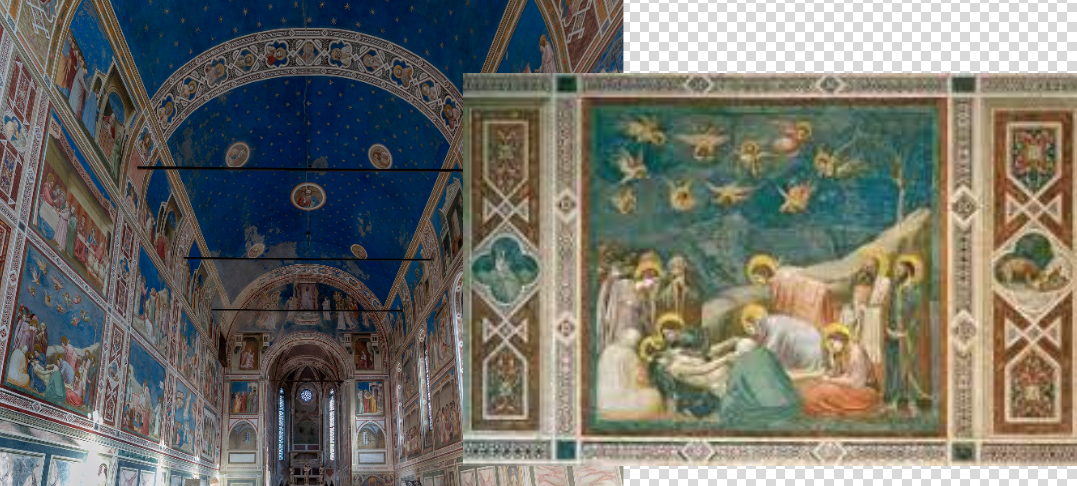
91
New cards

Golden Haggadah (The Plagues of Egypt, Scenes of Liberation, and Preparation for Passover)
1320 CE
Jewish
Illuminated manuscript (pigments and gold leaf on vellum)
Barcelona, Spain
Context: Haggadah = tells story of passover,
Content: Records history of origin of Passover, very luxurious, inspired by gothic and christian art,
Function: Show off wealth of owner, ceremonial for Passover (educational)
1320 CE
Jewish
Illuminated manuscript (pigments and gold leaf on vellum)
Barcelona, Spain
Context: Haggadah = tells story of passover,
Content: Records history of origin of Passover, very luxurious, inspired by gothic and christian art,
Function: Show off wealth of owner, ceremonial for Passover (educational)
92
New cards

Basin (Baptisetere de St. Louis)
1320 - 1340 CE
Mamluk
Brass inlaid with gold and silver
Louvre, France
Context: Unknown how it got to France but has Islamic origin (Egypt/Syria), signed by artist
Content: Depicts (muslim) military figures, has Muslim iconography, very intricate details, has symbol of France (unknown how it got there), registers, complex designs of abstract and nonabstract animals
Function: Used for baptism of French royals, shows power
1320 - 1340 CE
Mamluk
Brass inlaid with gold and silver
Louvre, France
Context: Unknown how it got to France but has Islamic origin (Egypt/Syria), signed by artist
Content: Depicts (muslim) military figures, has Muslim iconography, very intricate details, has symbol of France (unknown how it got there), registers, complex designs of abstract and nonabstract animals
Function: Used for baptism of French royals, shows power
93
New cards

Bahram Gur Fights the Karg, folio from the Great Il-Kanid Shahnama
1330 - 1340 CE
Islamic Persian
Ink, opaque watercolor, gold and silver on paper
Central Asia
Context: Made after Mongols first invaded, painted by mongols, Shahnama has lots of national pride in it for Iran,
Content: Stylized anatomy, bent and broken axis, Asian influence, depicts king defeating a horned wolf, king is warrior with weapon but also ruler with rich clothing, dynamic movement, Islamic calligraphy
Function: Manuscript: story of Persian kings, tribute to king, show owners wealth
1330 - 1340 CE
Islamic Persian
Ink, opaque watercolor, gold and silver on paper
Central Asia
Context: Made after Mongols first invaded, painted by mongols, Shahnama has lots of national pride in it for Iran,
Content: Stylized anatomy, bent and broken axis, Asian influence, depicts king defeating a horned wolf, king is warrior with weapon but also ruler with rich clothing, dynamic movement, Islamic calligraphy
Function: Manuscript: story of Persian kings, tribute to king, show owners wealth
94
New cards

The David Vases
1350 CE
Yuan Dynasty, China (Mongolian Empire)
White porcelain with cobalt blue underglaze
China (while part of Mongol empire)
Context: Shows influence from trade from the Silk Road, Elephants from India, Cobalt from Iran, Dragons and pheonixes from China, vines and flowers from Islam,
Content: Inscription states when and who made it and dedication to a general, contains registers, porcelain is very shiny and made of pure clay, inspiration from bronze vases, dragons and pheonixes are symbols of power for royalty
Function: Offering to temples
1350 CE
Yuan Dynasty, China (Mongolian Empire)
White porcelain with cobalt blue underglaze
China (while part of Mongol empire)
Context: Shows influence from trade from the Silk Road, Elephants from India, Cobalt from Iran, Dragons and pheonixes from China, vines and flowers from Islam,
Content: Inscription states when and who made it and dedication to a general, contains registers, porcelain is very shiny and made of pure clay, inspiration from bronze vases, dragons and pheonixes are symbols of power for royalty
Function: Offering to temples
95
New cards

Alhambra
1354 CE
Nasrid dynasty (Muslims)
Whitewashed adobe stucco, wood, tile, paint and gilding
Grenada, Spain
Context:
Content: Court complex enclosed in walls with only 4 entrances, built with safety in mind, complex geometric tiles, contains patio and pool, arches and double arches, lattice windows to let in light, “The remaining surfaces are covered with intricately carved stucco motifs organized in bands and panels of curvilinear patterns and calligraphy.”, maquarnas = vaulted honeycomb ceiling
Function: Residence for nobles, barracks for guards, place for court officials to live and work
1354 CE
Nasrid dynasty (Muslims)
Whitewashed adobe stucco, wood, tile, paint and gilding
Grenada, Spain
Context:
Content: Court complex enclosed in walls with only 4 entrances, built with safety in mind, complex geometric tiles, contains patio and pool, arches and double arches, lattice windows to let in light, “The remaining surfaces are covered with intricately carved stucco motifs organized in bands and panels of curvilinear patterns and calligraphy.”, maquarnas = vaulted honeycomb ceiling
Function: Residence for nobles, barracks for guards, place for court officials to live and work
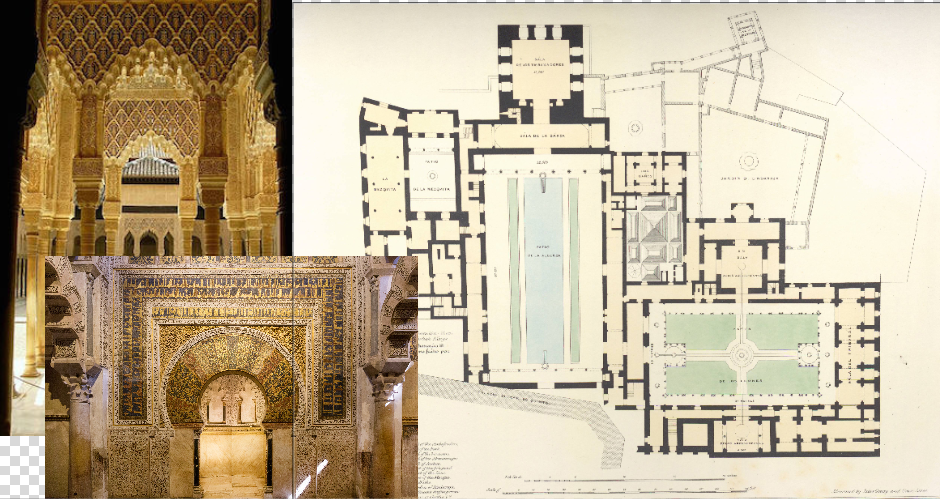
96
New cards
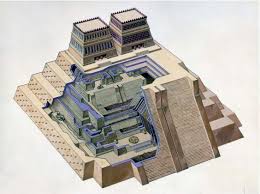
Templo Mayor
1375 - 1520 CE
Aztec
Stone (temple), volcanic stone (coyolxquahqui stone), jadeite (olmec mask), basalt (calender stone)
Tenochtitlan, Mexica
Context:
Content: Coyolxquahqui stone depicts diety with cut off limbs having been defeated with benk and broken axis and saggy boobs (to show age) and would be rolled to bottom of temple in ritual, Templo Mayor separated into 4 main parts, with 2 big staircases
Function: Temple is dedicated to gods, all have ritual/ceremonial functions
1375 - 1520 CE
Aztec
Stone (temple), volcanic stone (coyolxquahqui stone), jadeite (olmec mask), basalt (calender stone)
Tenochtitlan, Mexica
Context:
Content: Coyolxquahqui stone depicts diety with cut off limbs having been defeated with benk and broken axis and saggy boobs (to show age) and would be rolled to bottom of temple in ritual, Templo Mayor separated into 4 main parts, with 2 big staircases
Function: Temple is dedicated to gods, all have ritual/ceremonial functions

97
New cards

Forbidden City
1400 CE
Ming Dynasty
Stone masonry, marble, brick, wood and ceramic tile
Beijing, China
Context: Made after a royal rebellion
Content: Red walls, yellow roofs, each building style shows a rank or heirarchy, spaces clearly distinguish who and what can be where
Function: Political and ritual center, home of emporers,
1400 CE
Ming Dynasty
Stone masonry, marble, brick, wood and ceramic tile
Beijing, China
Context: Made after a royal rebellion
Content: Red walls, yellow roofs, each building style shows a rank or heirarchy, spaces clearly distinguish who and what can be where
Function: Political and ritual center, home of emporers,
98
New cards
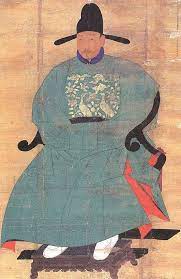
Portrait of Sin Sukju
1417 CE
Imperial Bureu of Painting
Hanging scroll (ink and color on silk)
Korea
Context: commemorates person in life and after death, Sin Sukju = prime minister
Content: Everything in image designates status (stool, clothing, chest design, hat), face is not idealized, its individualized and naturalistic
Function: Idolized relic of families past (stays with the family), display the power/authority of Sin Sukju
1417 CE
Imperial Bureu of Painting
Hanging scroll (ink and color on silk)
Korea
Context: commemorates person in life and after death, Sin Sukju = prime minister
Content: Everything in image designates status (stool, clothing, chest design, hat), face is not idealized, its individualized and naturalistic
Function: Idolized relic of families past (stays with the family), display the power/authority of Sin Sukju
99
New cards

Ruler’s feather headdress
1428 CE
Aztec
Feathers (quetzal+cotinga) and gold
Mexica
Context: Gift from 1 ruler to another, feathers were important to Aztecs and had big industry
Content: Shiny feathers, part of elaborate costume
Function: Display rulers status and wealth, costume
1428 CE
Aztec
Feathers (quetzal+cotinga) and gold
Mexica
Context: Gift from 1 ruler to another, feathers were important to Aztecs and had big industry
Content: Shiny feathers, part of elaborate costume
Function: Display rulers status and wealth, costume
100
New cards

Pazzi Chapel and Basalisca di Sante Croce (Filippo Brunelleschi)
1439 CE
Italian Rennaissance
Masonry
Florence, Italy
Context: Has humanist influence (greek and rome revival),
Content: Gray outlines emphasize shapes on walls, stained glass windows, frescoes, pointed arches, wooden ceiling, DOME AND OCULUS at top, radiating lines towards oculus, 12 windows at bottom of dome, heavenly, many rounded arches, very classical greek inspo
Function: Place of worship, place for (monks) to gather and pray and meditate
1439 CE
Italian Rennaissance
Masonry
Florence, Italy
Context: Has humanist influence (greek and rome revival),
Content: Gray outlines emphasize shapes on walls, stained glass windows, frescoes, pointed arches, wooden ceiling, DOME AND OCULUS at top, radiating lines towards oculus, 12 windows at bottom of dome, heavenly, many rounded arches, very classical greek inspo
Function: Place of worship, place for (monks) to gather and pray and meditate
